

The Stunning Ritz Carlton EVRIMA Yacht
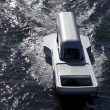
Gliding Across Tokyo’s Sumida River: The Mesmerizing Zipper Boat
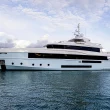
CROCUS Yacht: An 48 Meter Beauty by Admiral
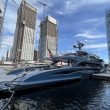
PHI Yacht – Royal Huisman’s $45 Million Superyacht
- Zuretti Interior Design
- Zuretti Interior
- Zuccon International Project
- Ziyad al Manaseer
- Zaniz Interiors. Kutayba Alghanim
- Yuriy Kosiuk
- Yuri Milner
- Yersin Yacht
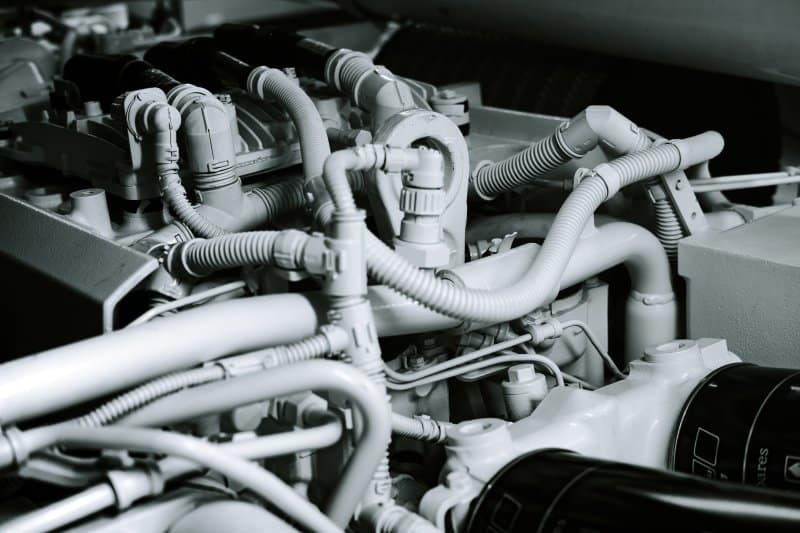
The Engines that Power Superyachts
The sight of a majestic superyacht is absolutely fascinating, but only few people actually know the different engine types that power these massive vessels.
The size of a yacht and its weight, which is given in gross tons, have considerable influence on the type of engine it will come with.
For that reason, the majority of superyachts usually do not only have one engine but actually several in most cases.
This post lists the most popular engines used in both smaller boats as well as some of the largest privately owned yachts in the world.
MTU engines
The manufacturer MTU is probably the most popular engine brand in the yachting industry, and their products can be found in vessels from all over the world.
Founded in 1909, MTU first produced engines for airships, most famously blimps, before specializing in the marine industry.
Today the engine manufacturer is also well known for its power train and locomotive, armored vehicle, haul truck engines as well as, of course, yachts.
Not only does MTU offer the best equipment for series and performance yachts, but also customized and specially manufactured engines for superyachts.
The world-renowned company advertises exceptional and powerful engines that are particularly quiet and low-vibration for maximum comfort and the best possible operating conditions.
For yachts, the MTU engine series 2000, 4000, 1163, and 8000 are the most common models and can reach a performance between 400 and 10000 KW or even 500 to 13400 HP.
The 162.5 meters (533 ft) ECLIPSE , currently the third largest yacht in the world, is equipped with not just one but four MTU 20V 1163 TB93 diesel engines allowing the giant vessel to reach top speeds of 25 knots.
Yachts That Use MTU Engines

MOONRISE Yacht: Exceptional $220 Million Superyacht
- Superyachts

NINA J Yacht – Awesome $15 Million Superyacht

ROCK.IT Yacht – Extravagant $69M Superyacht

SERENITY Yacht (42 Meters) – Luxurious $35M Superyacht
Caterpillar engines
The international brand Caterpillar is widely known for its mining vehicles, including excavators and trucks and is one of the leading manufacturers of high-quality and powerful industrial engines.
However, Caterpillar also manufactures different engines for the yacht industry and has become a top choice for mid-sized and large superyachts.
The yacht manufacturers Pride Mega Yachts, and Tourquise Yachts are known to put great trust in the engines of Caterpillar, choosing them time and time again for their most high-profile projects.
These include, for example, the ESTATEMENT with its 115 meters (377 feet) and the 77-meter (253 feet) GO, both of which are powered by Caterpillar engines.
Caterpillar offers a wide variety of yacht engines such as the series C12, C18, C32, 3512C as well as VM32C with a performance range between 500 to 8000 KW and 660 to 11000 HP.
At the moment Caterpillar manufactures 18 different models of the series mentioned above that are suitable for exclusive yachts, speedboats, and fishing vessels.
Yachts That Use Caterpillar Engines

Unveiling The Kensho Yacht: A 75-Meter Masterpiece

007 Yacht – 49.0m Luxury Superyacht

SEVEN SINS Yacht – Pinnacle $25M Superyacht

DYTAN Yacht – Stunning 74m Superyacht
MAN engines
MAN SE is a well-known machine manufacturer from Germany, established in 1758 and recently merged to form Traton SE. T
he company has made a name for itself in truck and bus manufacturing and produces different types of engines and machines.
MAN’s most famous project in the boating industry was in 1987 when they supplied a total of nine four-stroke diesel engines for the cruise ship Queen Elizabeth II, which at that time was considered the largest engine for a vessel carrying passengers.
On the water, MAN offers 12 different engines for yachts as well as fishing boats. Their popular i6 series has three different engines which have an output from 537 to 625 KW, which corresponds to 730 to 850 HP.
The V8 series also has three engines which range between 735 and 956 KW (1000 to 1300 HP).
The most powerful yacht engine series by MAN is the V12 model. With an output range of 1029 up to 1471 KW, these powerful engines provide 1400 to 2000 HP per engine.
SEMT Pielstick
The 147-meter (482 ft.) PRINCE ABDULAZIZ is one of the largest yachts in the world, relying on Pielstick engines.
She is powered by two 5,816 kW Pielstick diesel generator sets that produce an astonishing cruising speed of 18 knots, which is considerable for her size.
Since 2006, SEMT Pielstick, which originally mainly produced engines for locomotives, power plants, and naval and merchant’s vessels, has actually been part of MAN, although the brand SEMT remains.
Pielstick was originally based in France, and in addition to producing engines for superyachts, the company built power plants and locomotive engines.
Yachts That Use Pielstick Engines

ATLANTIS II Yacht – Serenity $100M Superyacht

PRINCE ABDULAZIZ Yacht – Stunning $100M Superyacht

A+ Yacht – Exclusive Haven $450 Million Superyacht
Wärtsilä engines
While companies like MAN or Caterpillar have become household names, Wärtsilä is a somewhat lesser-known engine manufacturer in the yachting industry.
The Finnish brand was founded in 1834 and has worked on very large projects like the 82-meter ALFA NERO, the 106-meter BLACK PEARL, and the 84-meter SAVANNAH.
Wärtsilä is therefore not to be underestimated, and their experience in the energy sector makes their engines extremely efficient and highly innovative.
In addition to traditional diesel and gas engines, Wärtsilä also manufactures propellers, marine control systems, and water management solutions.
The majority of their projects are, however, industrial, although it is expected that Wärtsilä will most likely work on more superyachts in the future, given their innovative approaches.
Yachts That Use Wärtsilä Engines

PELORUS Yacht – Sumptuous $250 M Superyacht

DILBAR Yacht – Glamorous $800M Superyacht

SAMAR Yacht – Luminous $100M Superyacht

DREAM Yacht – Dazzling $150 Million Superyacht
Do you have anything to add to this listing?
Love yachts join us., related posts.
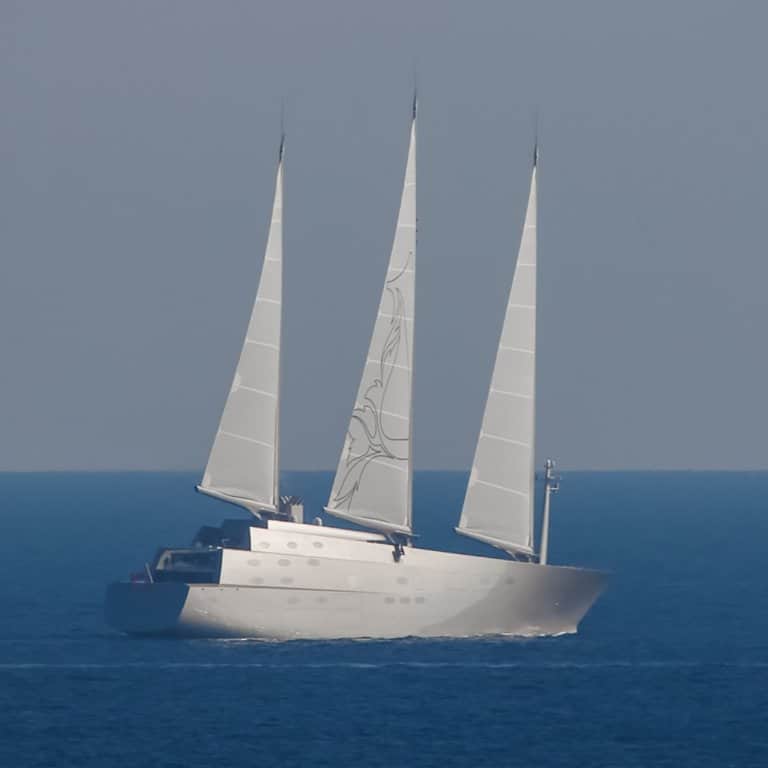
Top 10 Biggest Sailing Yachts In The World
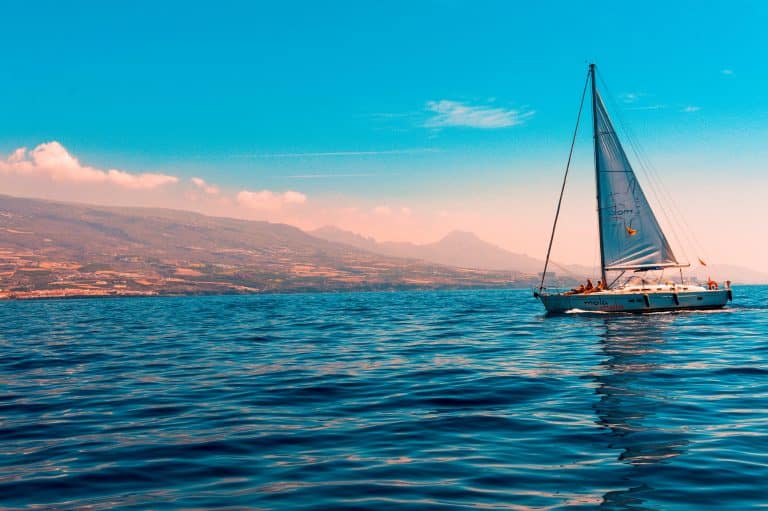
Renaming A Boat – Is It Bad Luck?
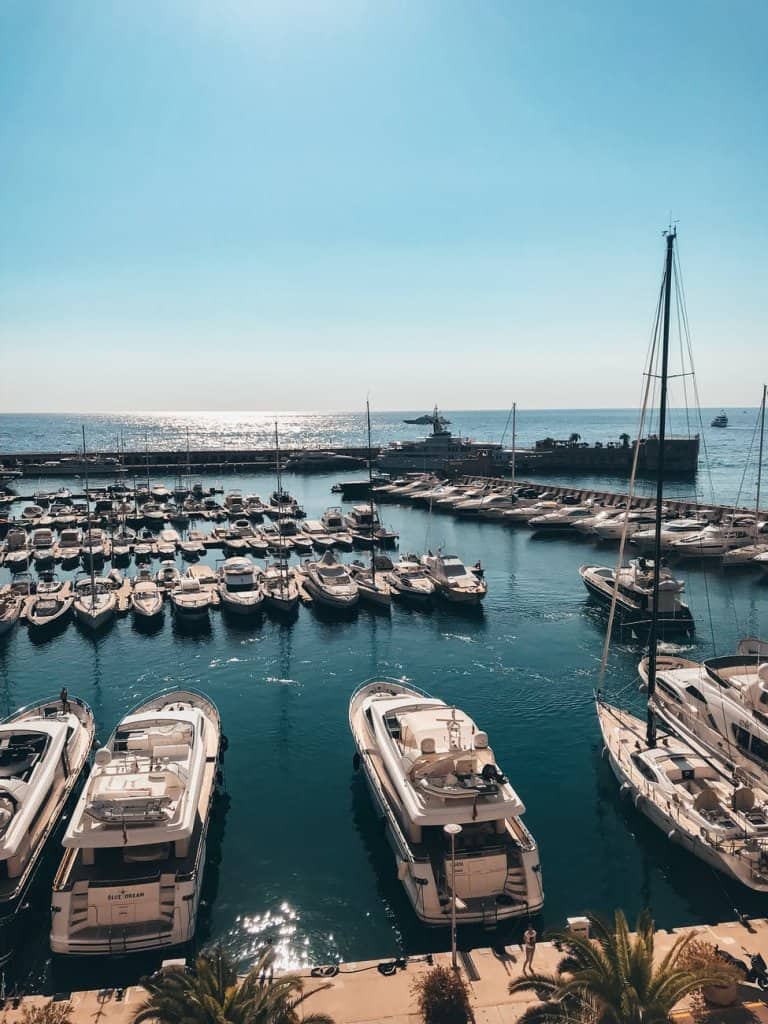
13 Awesome Superyacht Marina Destinations
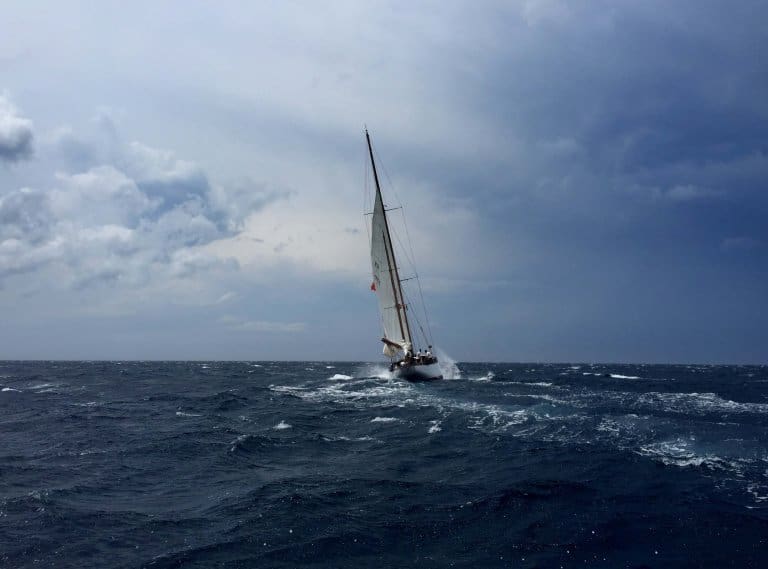
9 Sailing And Boat Superstitions

Try now - Live tracking map for yachts and other vessels
Real time world map for tracking yachts and all other vessels like speed boats, cargo or tankers! Tracking yachts and other vessels was never so easy!
The Need for Speed: Exploring the World’s Fastest Superyachts
In the realm of luxury yachts, where luxury knows no bounds, there exists a class of vessels that stands apart – vessels that blend luxurious living with exhilarating speed. Welcome to our exploration of “The Need for Speed: Exploring the World’s Fastest Superyachts.” In this exhilarating journey across the high seas, we unveil the marvels of modern engineering and design, showcasing a selected group of superyachts that defy convention with their remarkable velocity. From cutting-edge propulsion systems to breathtaking top speeds, join us as we delve into the world of high-performance yachting, where luxury knows how to pick up the pace.
Cutting-Edge Propulsion Technologies in World’s Fastest Superyachts
Conventional diesel engines.
Many superyachts, even the fastest ones, are powered by conventional diesel engines. These engines typically run on marine-grade diesel fuel.They use a system of pistons and crankshafts to convert the energy from diesel combustion into mechanical power, which turns the yacht’s propellers. These engines are reliable and fuel-efficient, providing the necessary power for cruising.
Gas Turbine Engines
Some high-performance yachts, especially military and custom-built vessels, use gas turbine engines. These engines are known for their exceptional power-to-weight ratio. They have the ability to provide a high amount of thrust, which results in impressive speeds. Gas turbine engines are often used in combination with other propulsion systems or in hybrid setups for improved efficiency.
Hybrid Propulsion Systems in Fastest Superyachts
In recent years, there has been a trend towards hybrid propulsion systems. They combine traditional diesel engines with electric motors and batteries. These systems offer greater flexibility, allowing yachts to operate in all-electric mode for silent and emission-free cruising at lower speeds, and then switch to diesel power for high-speed operation. Hybrid systems are more environmentally friendly and can improve fuel efficiency.
Waterjet propulsion is a technology commonly used in high-speed yachts. Waterjets draw water into the yacht and expel it at high velocity through a nozzle at the stern. This system provides excellent maneuverability, shallow draft capabilities, and reduced vibration, making it suitable for fast and agile yachts.
Pod propulsion systems, such as those manufactured by companies like Volvo Penta and Caterpillar, involve the use of pods (outdrive units) that are mounted below the yacht’s hull. These pods can rotate, providing thrust in various directions, resulting in increased maneuverability and efficiency. They are often used in combination with diesel engines for both power and control.
Advanced Hull Designs
Beyond propulsion systems, the hull design of a yacht plays a crucial role in achieving high speeds. Yachts with planing hulls are designed to lift out of the water at higher speeds, reducing hydrodynamic drag and allowing for increased velocity.
Crafting the Perfect Propulsion Strategy for Fastest Superyachts
The selection of a propulsion system for a superyacht is a multifaceted decision that hinges on several critical factors, including the vessel’s size, intended purpose, and the preferences of its owner. Each propulsion method comes with its unique set of advantages and trade-offs, making it crucial to tailor the choice to suit the yacht’s specific requirements. Moreover, it’s not uncommon to witness a synergy of multiple propulsion systems within a single yacht, a testament to the industry’s dedication to optimizing both performance and efficiency. The pursuit of the perfect balance between speed, range, maneuverability, and environmental impact underscores the meticulous craftsmanship and innovation inherent in the design and engineering of these high-speed marvels.
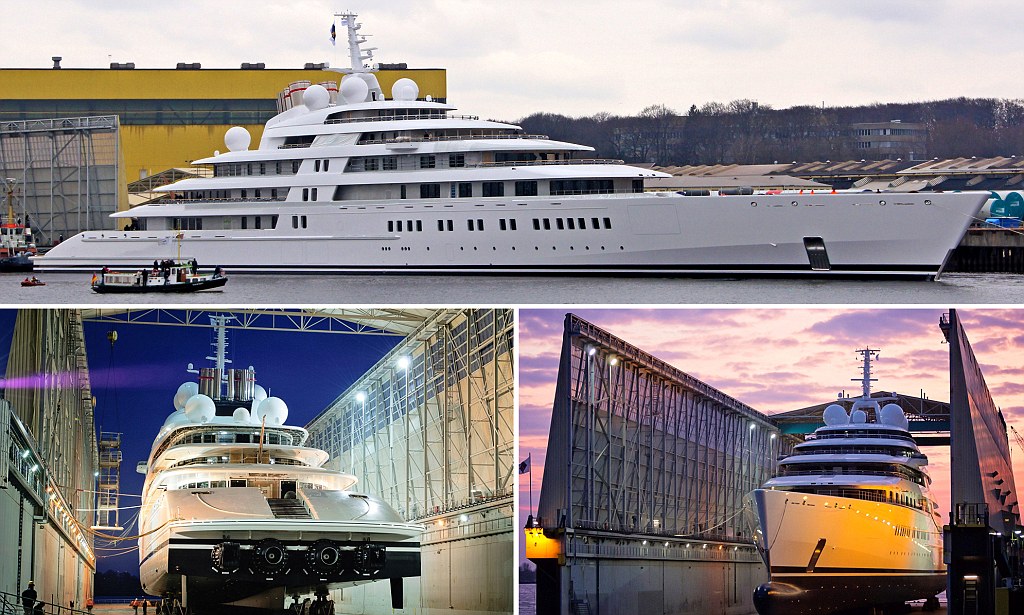
If you want to explore other mega yachts CLICK HERE
Or if you feel lucky and you think that you can find some of these yachts on a map, CLICK HERE to visit our Live tracking map for luxury yachts and other vessels.
Related Images:
Share this with your friends:.
- Yacht Tracking Map Find mega yacht
- Fun Map Map The World
- Privacy Policy

The 20 Fastest SuperYachts in the World
By Alex Holmes
Updated on August 14, 2023
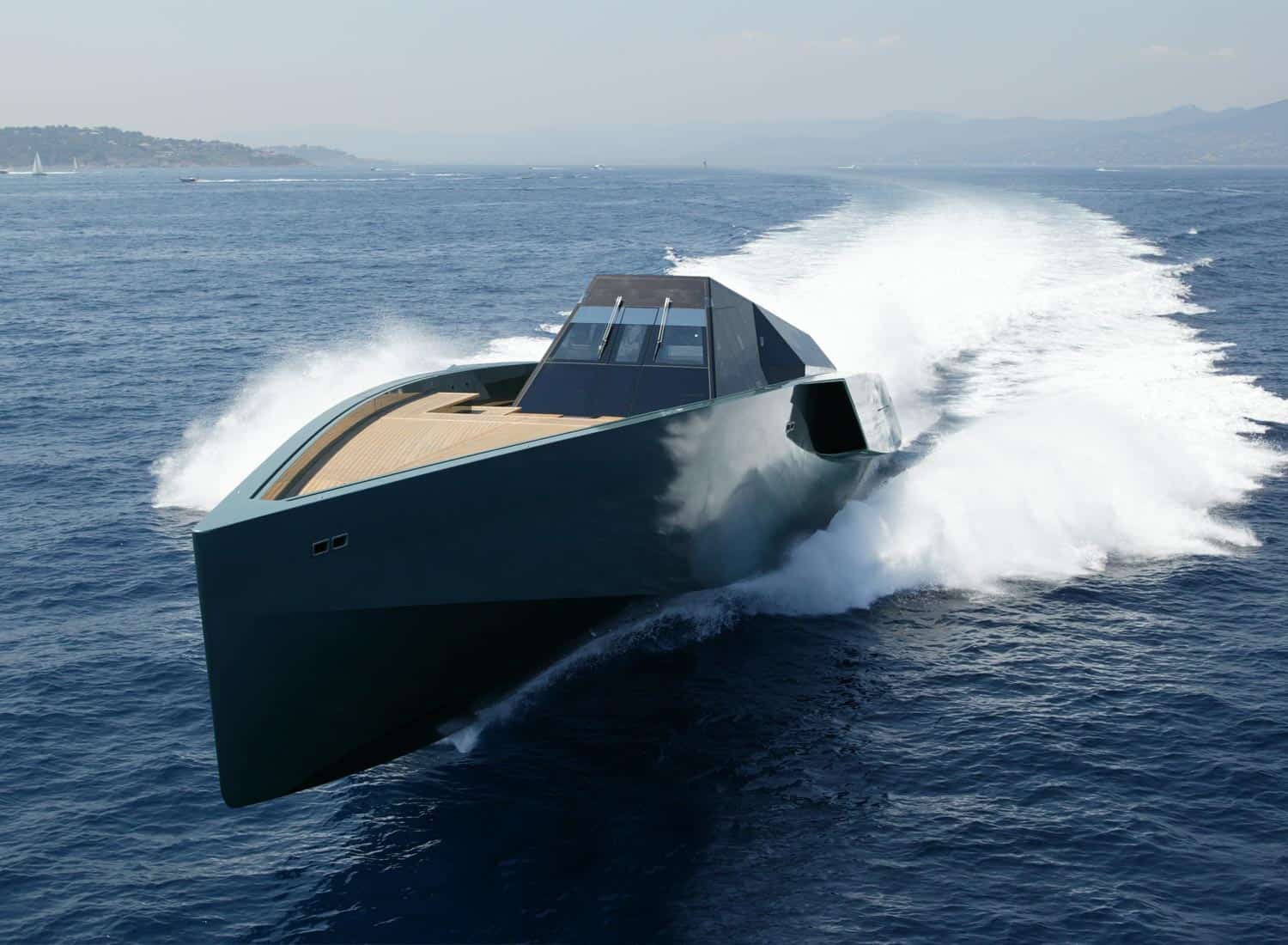
Yachts were always associated with leisure, comfort, and luxury, floating gently in a gorgeous location or cruising unhurried to the next, but somewhere along the way, something changed. Yachts started becoming faster and more powerful, and their owners more obsessed with these characteristics than anything else. But that’s the way with every kind of vehicle these days, isn’t it?
Mankind is obsessed with speed. That’s a given. And it applies to everything, including superyachts, which, despite their size, can achieve impressive speeds over water.
Whether that speed is actually needed is debatable, but one can’t ignore that there are quite a few capable yachts out there and that the competition for the fastest superyacht in the world is a fierce one, as in everything that involves the man’s thirst for speed.
The following superyachts manage to blend both the need for speed and the craving for luxury. But these are above everything else, the fastest yachts in the world right now.
Let’s have a look.
- 20. Cara Montana – 45 knots
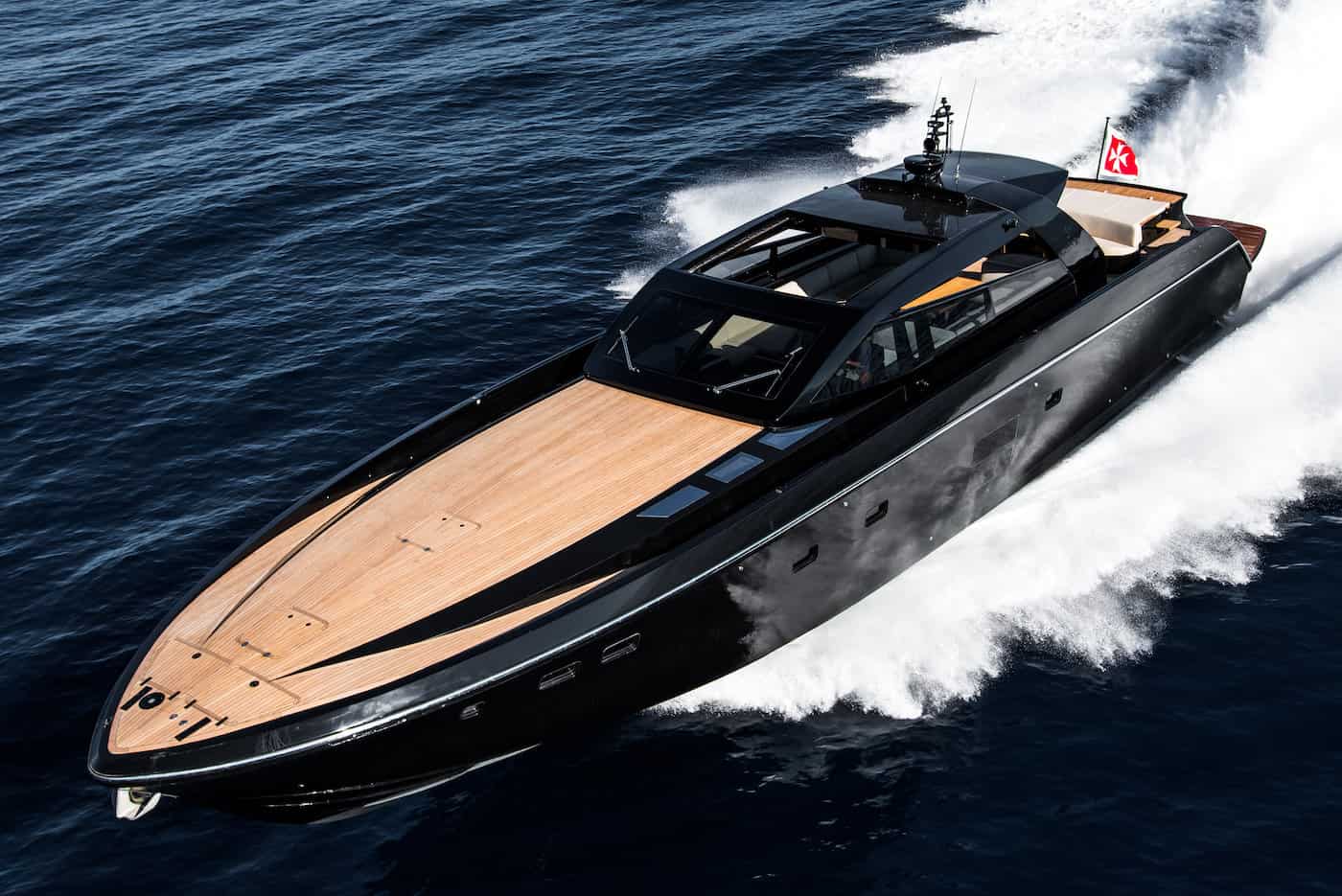
Cara Montana is a smaller yacht, manufactured in 2019 by a shipyard based in Genoa, called Otam. It’s a gorgeous maritime vehicle which spans only 25.9 meters in length, but is beautiful and powerful enough to impress.
Powered by twin MTU engines, outputting a total of 5,200 hp together, and equipped with twin surface drives, Cara Montana is able to reach a top speed of 45 knots, or just under 52 mph.
- 19. Alamshar – 45 knots

Completed in 2014 after a waiting time of 13 years spent in the manufacturing process, the Alamshar yacht can reach 45 knots, thanks to its twin Rolls-Royce Marine engines and three waterjets.
The naval architecture of the vessel was made by Donald L. Blount & Associates, the exterior design by Pininfarina, and the interior by Redman Whiteley Dixon. The whole project was put together by the Devonport shipyard in Falmouth, United Kingdom.
The Alamshar is 50 meter long, and costed a jaw dropping $200 million, paid by Aga Khan IV, for whom the custom yacht was made.
- 18. Moon Goddess – 45 knots
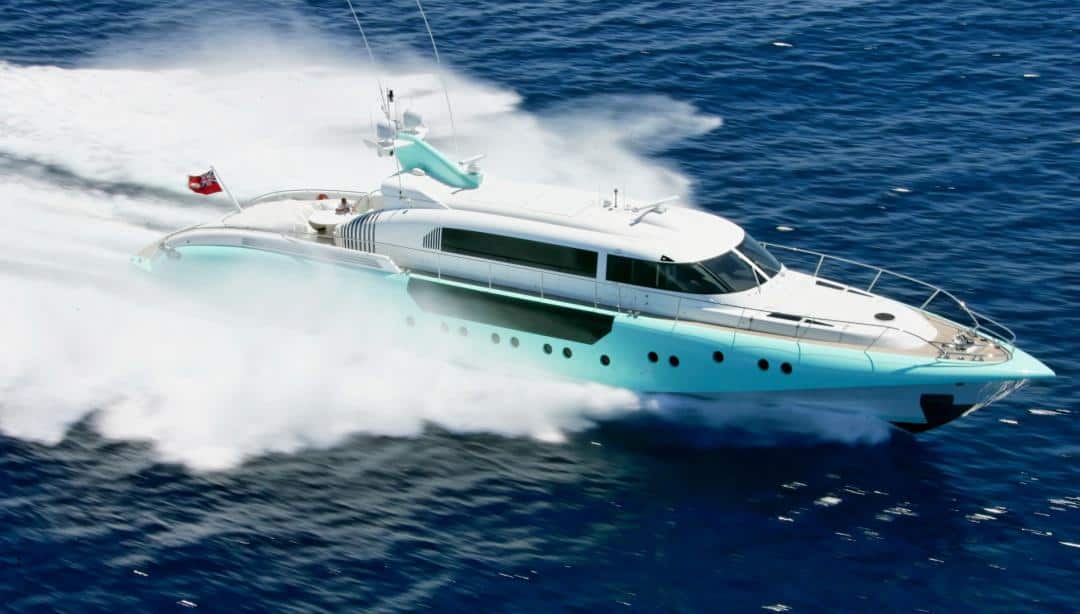
Another lovely vessel from the superyacht world is the Moon Goddess. It’s on the smaller size, being only 35 meter long, but it’s capable of reaching 45 knots. The ship was built by Danish Yachts, with the naval architecture and exterior designs made by Espen Øino, a superyacht design icon.
The Moon Goddess can take up to six guests in three posh cabins, two twins and one for the owner, plus a crew of five. It’s propelled to a cruise speed of 25 knots, or the maximum of 45, by twin MTU 16V 4000 M90 diesel engines which generate a combined 7,498 hp.
- 17. Shergar – 45 knots

The acclaimed German shipyard Lürssen built Shergar in 1983 to be among the fastest yachts in the world. Decades later, it still holds its own among better and more technological advanced vessels.
Equipped with two MTU 12V 396 TB83 diesel power plants, and two Allison 571-KF gas turbines, the Shergar is capable of cruising at 40 knots and reaching a top speed of 45 knots.
- 16. Seafire – 46 knots
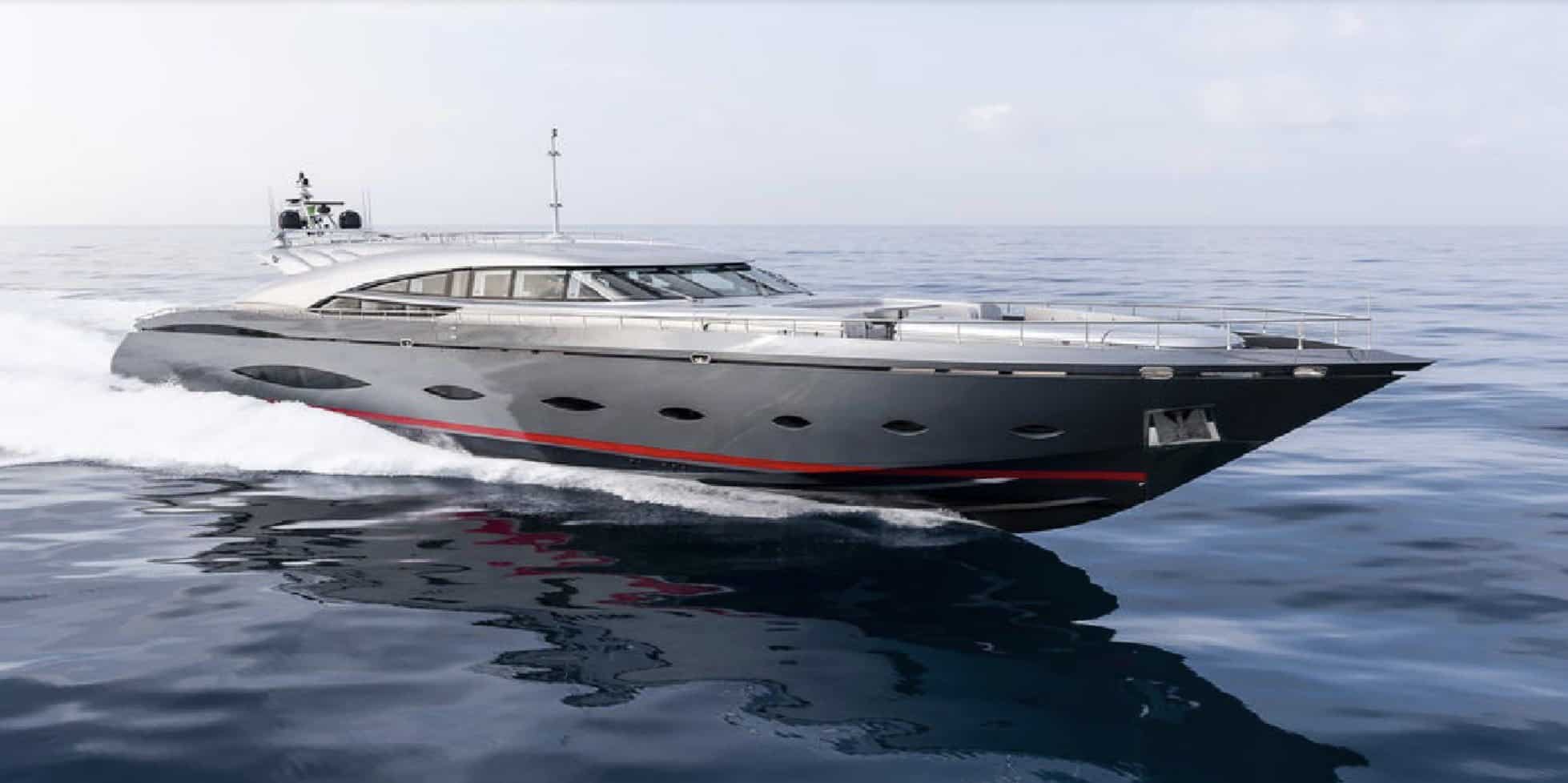
Seafire is a super yacht manufactured by AB Yachts, an Italian shipyard known for some impressive vessels. This one is among their fastest, able to reach a top speed of 46 knots.
The 42 meter super yacht is powered by a setup of three MTU 16V M94 units and three waterjets, giving it the possibility to cruise at an impressive speed of 43 knots, only 3 below its top speed.
- 15. Octopussy 007 – 53.2 knots

Built back in 1988 by the renowned Dutch shipyard Heesen Yachts and carrying a little of James Bond in its name, the Octopussy 007 is a 43.5 meter super yacht that can accommodate up to 10 guests and 7 crew members.
The vessel is powered by three MTU diesel engines that deliver 10,440 hp together, propelling the Octopussy forward at a cruising speed of 25 knots and a top speed of 53.2 knots.
It was on display at multiple boat shows around the world, and it changed owners for the last time in 2021. The naval architecture was done by Mulder Design, the exterior by Gerhard Gilgenast, and the interior by Art Line and Joachim Kinder Yacht Design.
Inside, it comes with 5 posh and extremely comfortable guest cabins, 1 master, 1 twin, and 3 double.
- 14. Daloli – 54 knots
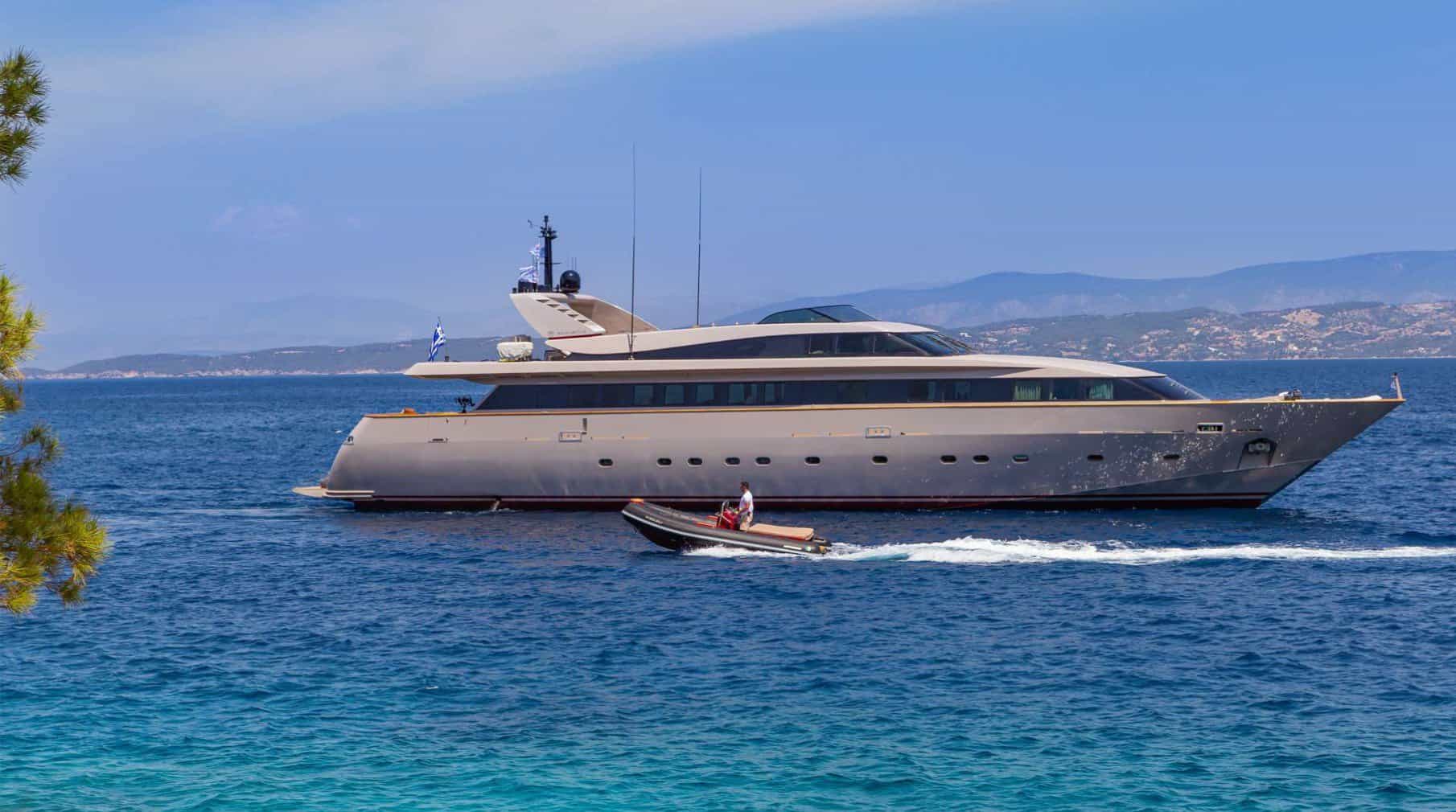
The Daloli, also known as Pandion, built by Heesen Yachts, is a 36.5 vessel that enters the category of super yachts and impresses with a top speed of 54 knots, the equivalent of just over 62 mph.
The ship has a crew capacity of 6 and can host up to 8 passengers. There’s four cabins in total on its three decks, and the sheer beauty of its design can be seen both inside and on the outside.
It’s a real beauty, and a fast one as well.
- 13. Why Not U – 55 knots
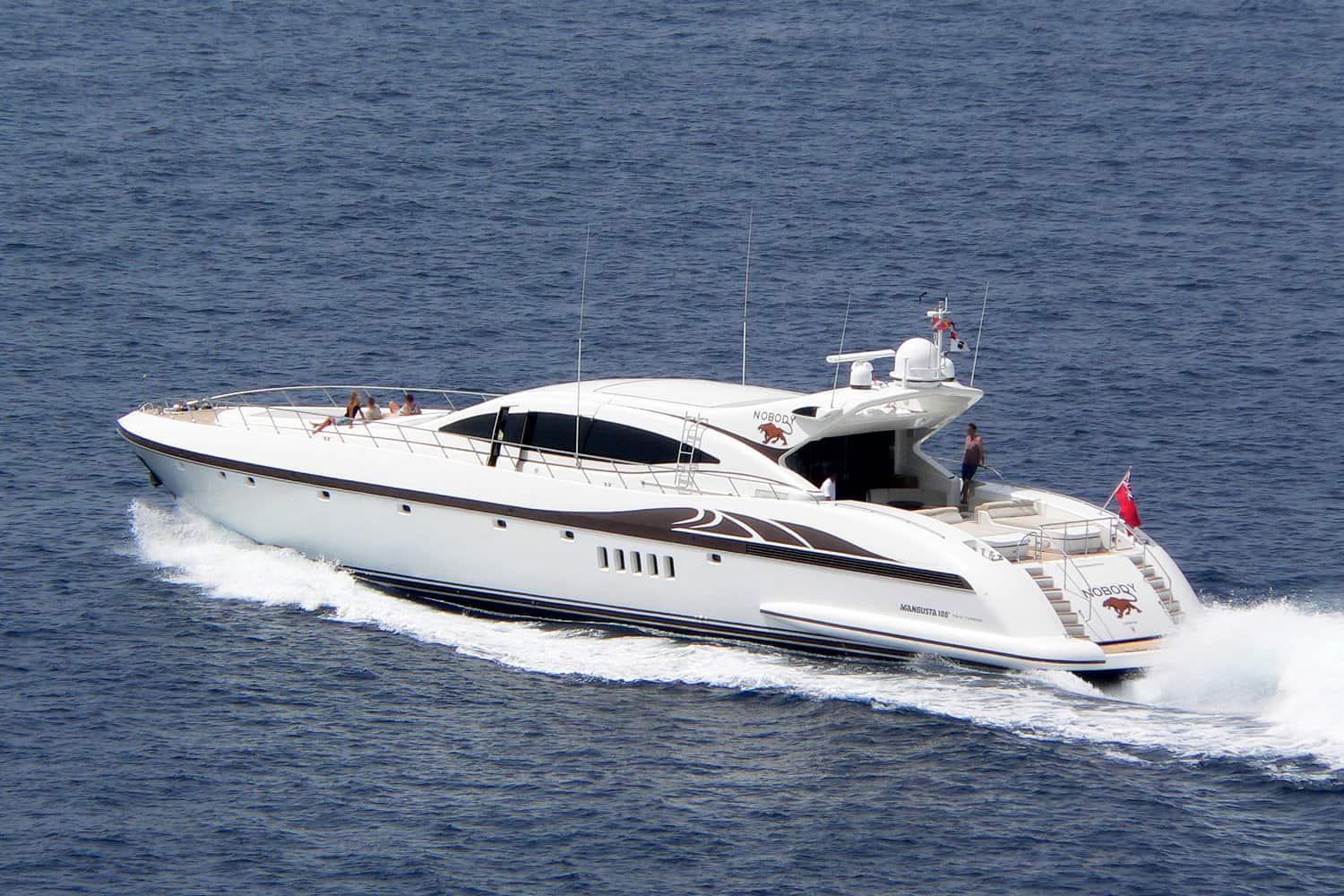
Originally named Nobody, the Why Not U was designed in 2001 by Overmarine as a deluxe super yacht that’s capable of getting his 9 guests and 3 crew to their next dream destination with a top speed of 55 knots. The power comes from a setup of Vericor TF40 gas turbine engines.
When it comes to living on it, it offers an impressive range of amenities on its teak decks. There’s several dining spots, entertainment and lounge rooms, sun bathing areas, and plenty more to be had on board of this stunning super yacht.
- 12. Ermis² – 57 knots

The 37.5 meter super yacht Ermis², manufactured from special materials by the New Zealand shipyard McMullen & Wing, is among the fastest vessels out there, capable of a top speed of 57 knots, which is just a little over 65 mph.
The ship came out in 2007, but is still among the most innovative yachts in the world given the mix of composite materials, aerospace grade carbon fiber and titanium for its lightweight body.
That low weight, combined with the 10,944 hp outputted by the three MTU 16V 4000 M90 engines, allow this stunning yacht to reach that max speed of 57 knots.
- 11. Chato – 57 knots
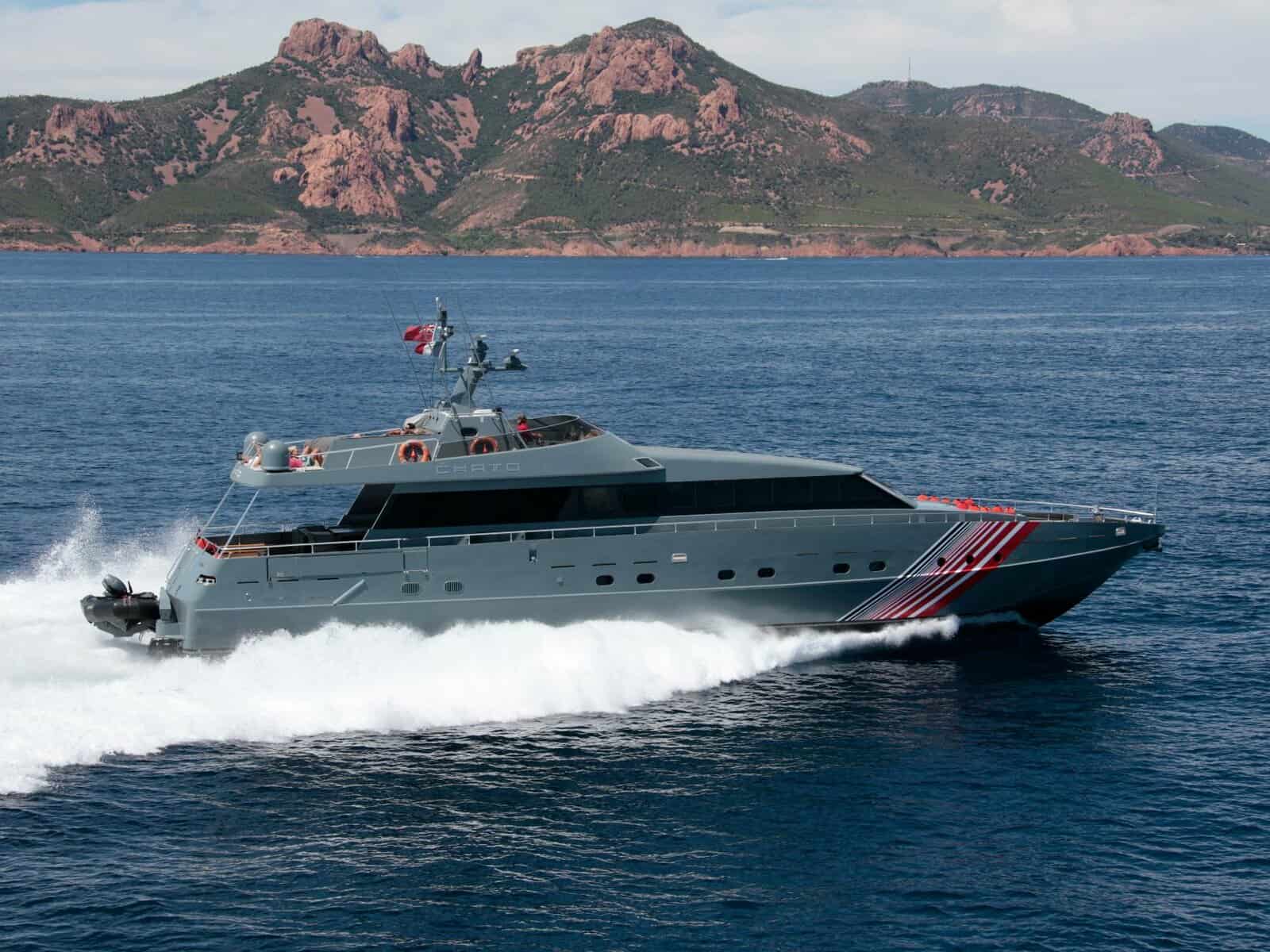
Chato is another small sized and powerful super yacht. It was built in 1986 by Baglietto from aluminium and was equipped with twin MTU 16V 396 TB94 diesel engines, which push it to a cruise speed of 35 knots and a max speed of 57 knots.
Chato is only 25.79 meters long, and that helps with a lower weight and a smaller profile under the surface of the water.
- 10. Azimut Atlantic Challenger – 60 knots
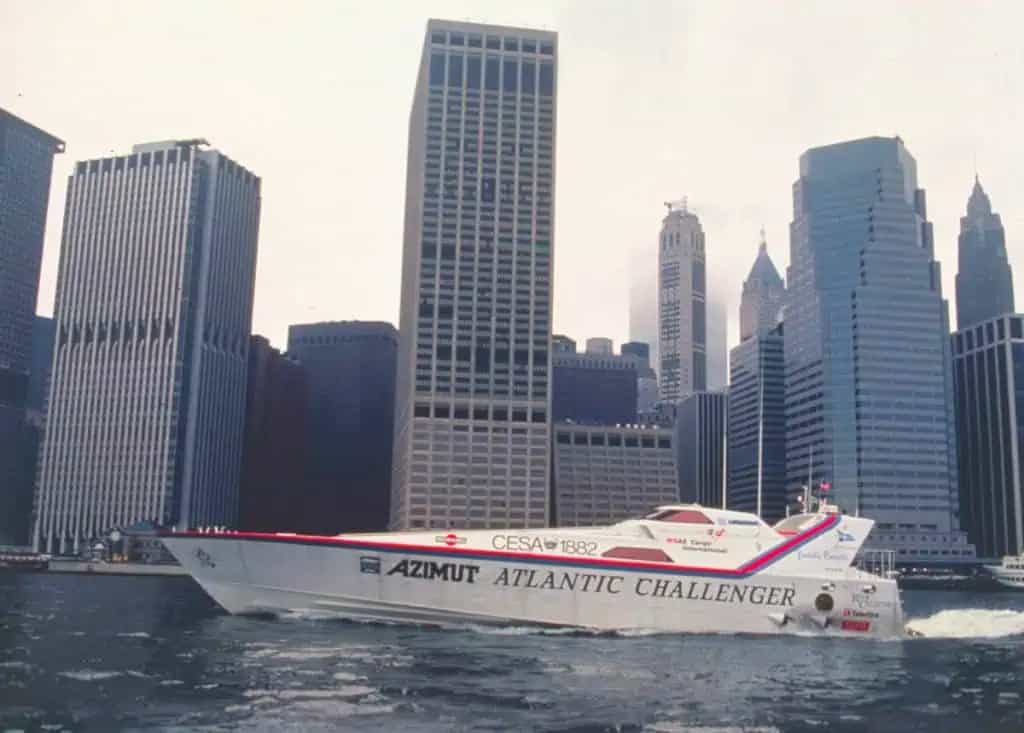
The Azimut Atlantic Challenger strays away from the usual design of luxury yachts, but that only because it was built for a very different purpose, which was to win the Blue Riband award, an unofficial accolade given to a ship for making the fastest transatlantic crossing.
Unfortunately, the Azimut Atlantic Challenger failed to win, but it remained one of the fastest super yachts in the world, currently holding the 10th position, with a top speed of 60 knots.
It was built in 1988 by the Italian shipyard Benetti, with the exterior designed by Pininfarina. It’s a 26.82 meter aluminum monohull vessel and is powered by four CRM diesel engines, capable of outputting a combined 7,400 hp.
- 9. Jet Ruban Bleu – 60 knots

The French built Jet Ruban Bleu is on par with the Azimut Atlantic Challenger and two other super yachts, at least when it comes to the top speed. They can all do 60 knots.
Jet Ruban Bleu is 25 meter long, was designed by Gilles Ollier and Coste Design & Partners and created by Multiplast. It was outfitted with a single MTU engine capable of 3,500 hp alone.
- 8. Oci Ciornie – 60 Knots
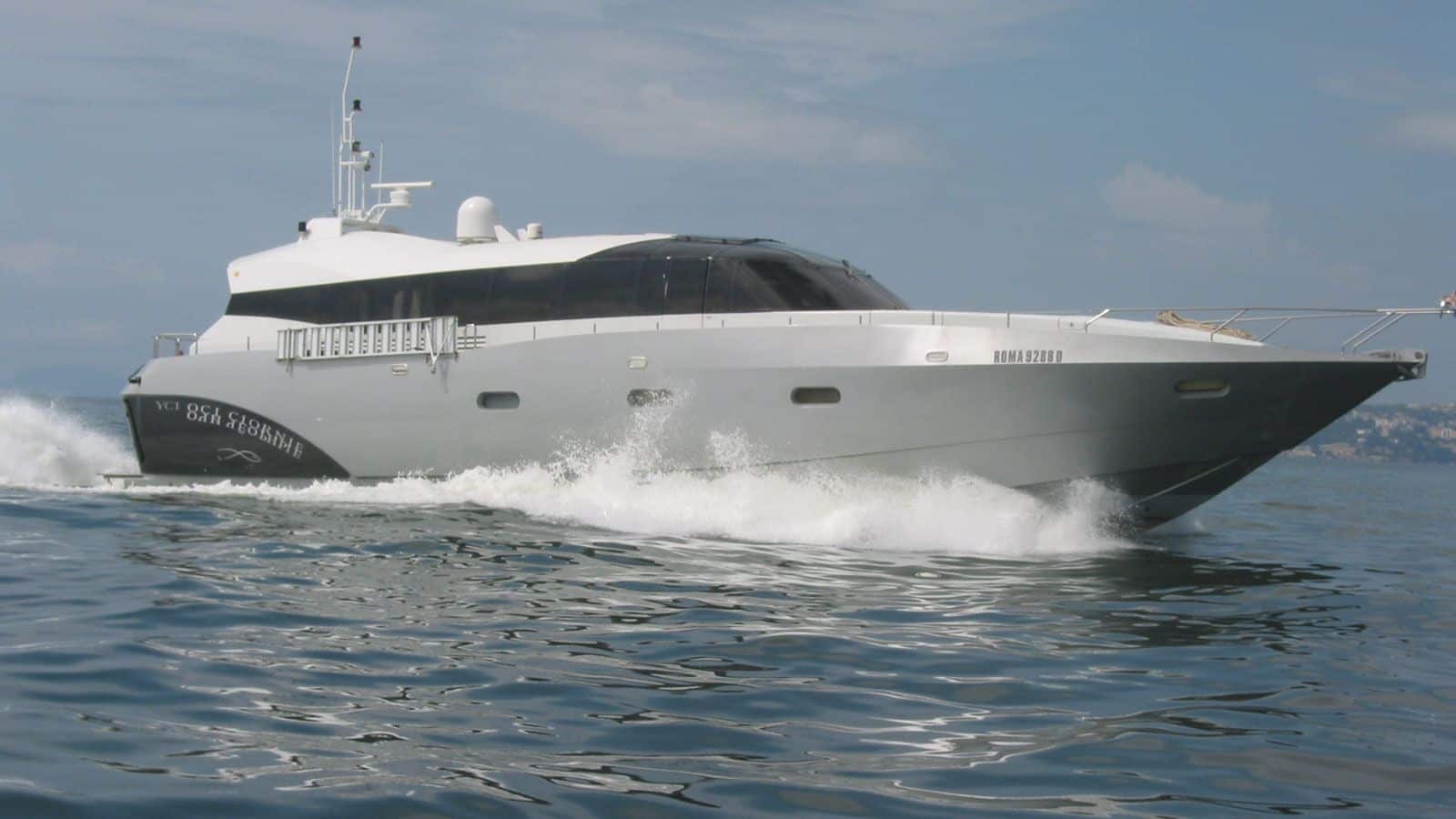
Oci Ciornie was a super yacht project that was realized by American shipyard Palmer Johnson, the Dutch Vripack, and the well known naval architect Don Shead in 1998.
The vessel features an aluminum hull, and uses two 1,800 hp MTU 16V 2000 M90 engines, a 4,600 hp AVCO Lycoming gas turbine, plus Arneson surface drives. This combination propels the Oci Ciornie with a top speed of 60 knots.
The ship is able to carry up to eight guests in a master suite, a double cabin, and a twin room. There’s a nice and streamlined deck that features a superb saloon and outside areas for relaxation, while the interior takes inspiration from aircraft designs.
- 7. Brave Challenger – 60 Knots
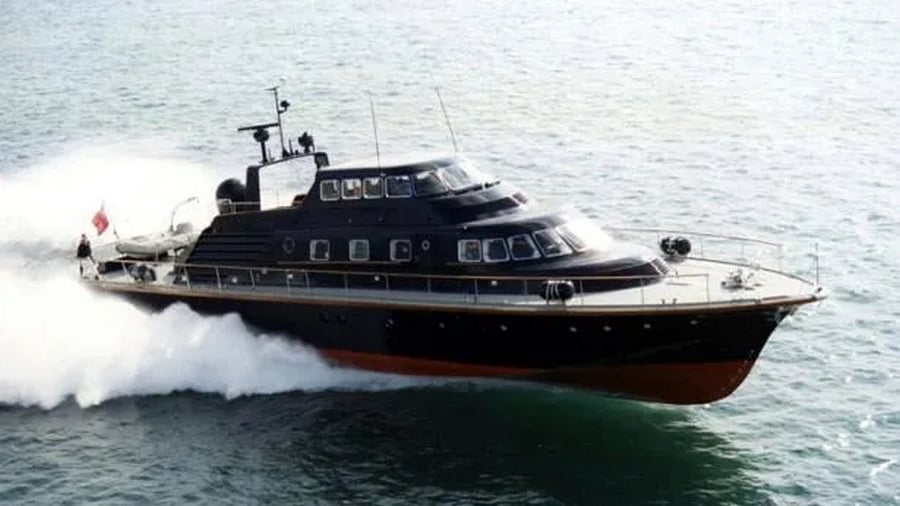
With the same 60 knot top speed of the above ships, the Brave Challenger is to be lauded, since it’s much older, being built back in 1960. The project was completed by Vosper Ltd in Portsmouth, United Kingdom, with the intention of becoming a Brave Class fast patrol boat. It was only later that the ship was converted for private use.
The Brave Challenger is powered by three Rolls-Royce Proteus gas turbines, which output a total of 13,500 hp, which combined with the only 31 meter length and lower weight, can push the boat to the top speed of 60 knots.
- 6. Kereon – 62.3 Knots

The Italian yard AB Yachts, the one behind Seafire above at number 16, built in 2004 one of the fastest super yachts in the world, the Kereon. It’s capable of hitting a top speed of 62.3 knots, and that thanks to the three CRM diesel engines that produce a good 6,300 hp.
Since the total power is so low in comparison to others on this list, it makes sense that a shorter length of 27 meters and a performant hull design are at play to aid in reaching those speeds.
The ship has a very sporty aesthetic, all metallic silver, and can cruise at 50 knots for about 900 miles.
- 5. Gentry Eagle – 63.5 knots

Gentry Eagle was a special project done by Vosper Thornycroft in 1988 for the legendary Tom Gentry, who achieved almost everything he could achieve in terms of powerboat speed records during his lifetime, including the coveted Blue Riband. The vessel, capable of 63.5 knots, helped him win the Blue Riband in 1989, with a record time of 62 hours and 7 minutes.
Gentry Eagle’s design was done by Grant Robinson and Peter Birkett, with the interior by Robin Rose. In 1992, the ship became a private super yacht.
- 4. Galeocerdo – 65 Knots

Galeocerdo is a very futuristic looking ship, with sleek lines and a hull designed to maintain high speeds in rough sea conditions. It measures 36 meters in length, and is capable of hitting 65 knots.
The vessel was built in 2003 in Italy, by Rodriguez Yachts and is powered by three Vericor TF50 gas turbines, each tied to a Rolls-Royce Kamewa water jet. The total power output rises to a whooping 16,800 hp.
- 3. Destriero – 66 knots
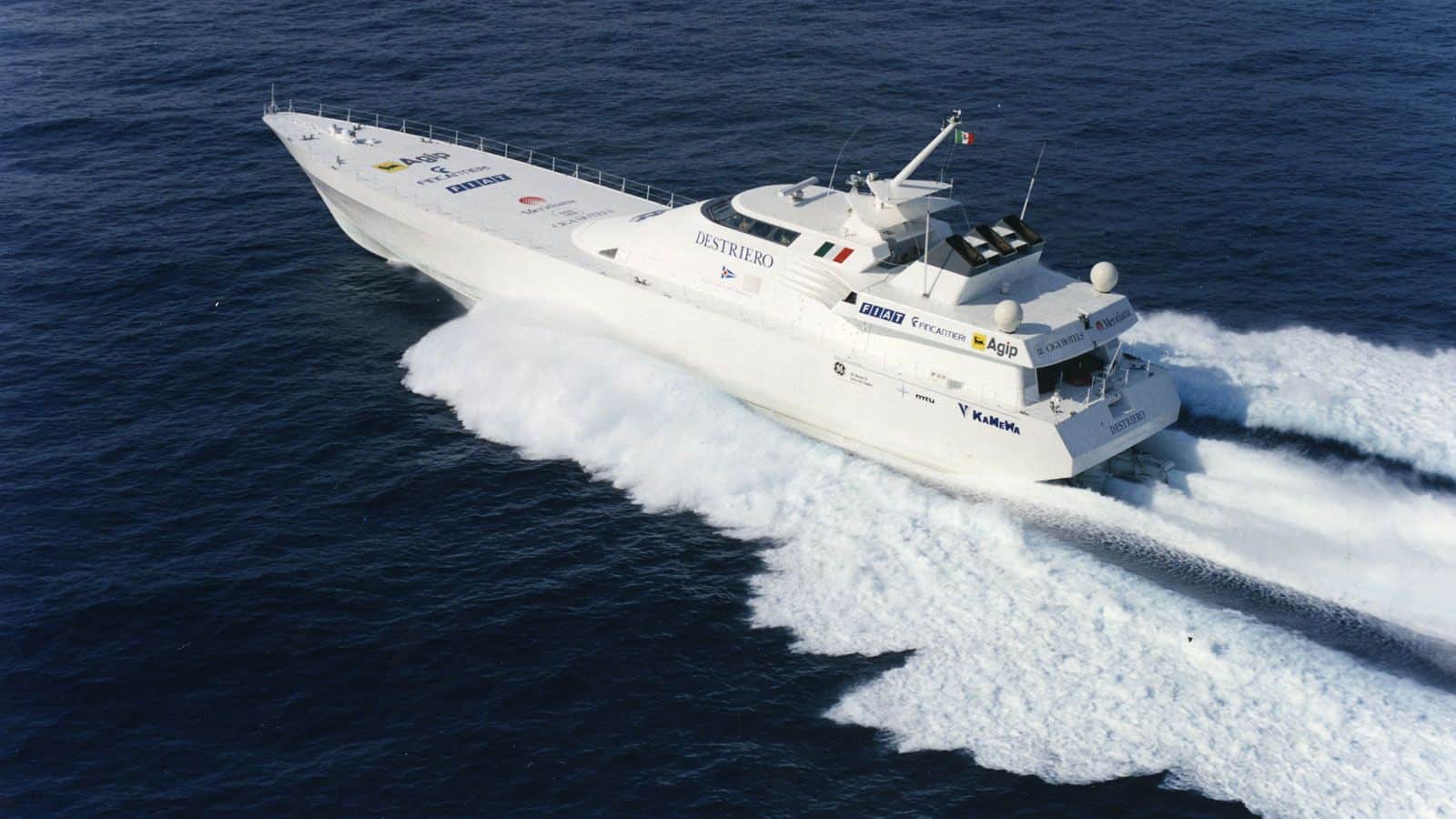
Destriero was launched back in 1991 by the Italian shipyard Fincantieri. It has a length of 68.18 meters and features a design made by Pininfarina and Donald Blount. This ship was again built with the sole purpose of winning the Blue Riband by breaking the old record of crossing the Atlantic.
She did it in 1992, after it crossed the ocean twice without refueling, setting a new record of 58 hours, 34 minutes, and 5 seconds. but the Blue Riband award was denied for her, since it’s awarded only to passenger vessels and not private yachts.
What allowed Destriero to set a new record was the power of 54,000 hp, given by the Codag engine and the three GE Aviation LM1600 gas turbines, pushing the ship to a max speed of 66 knots, or 76 mph.
- 2. World Is Not Enough – 67 Knots
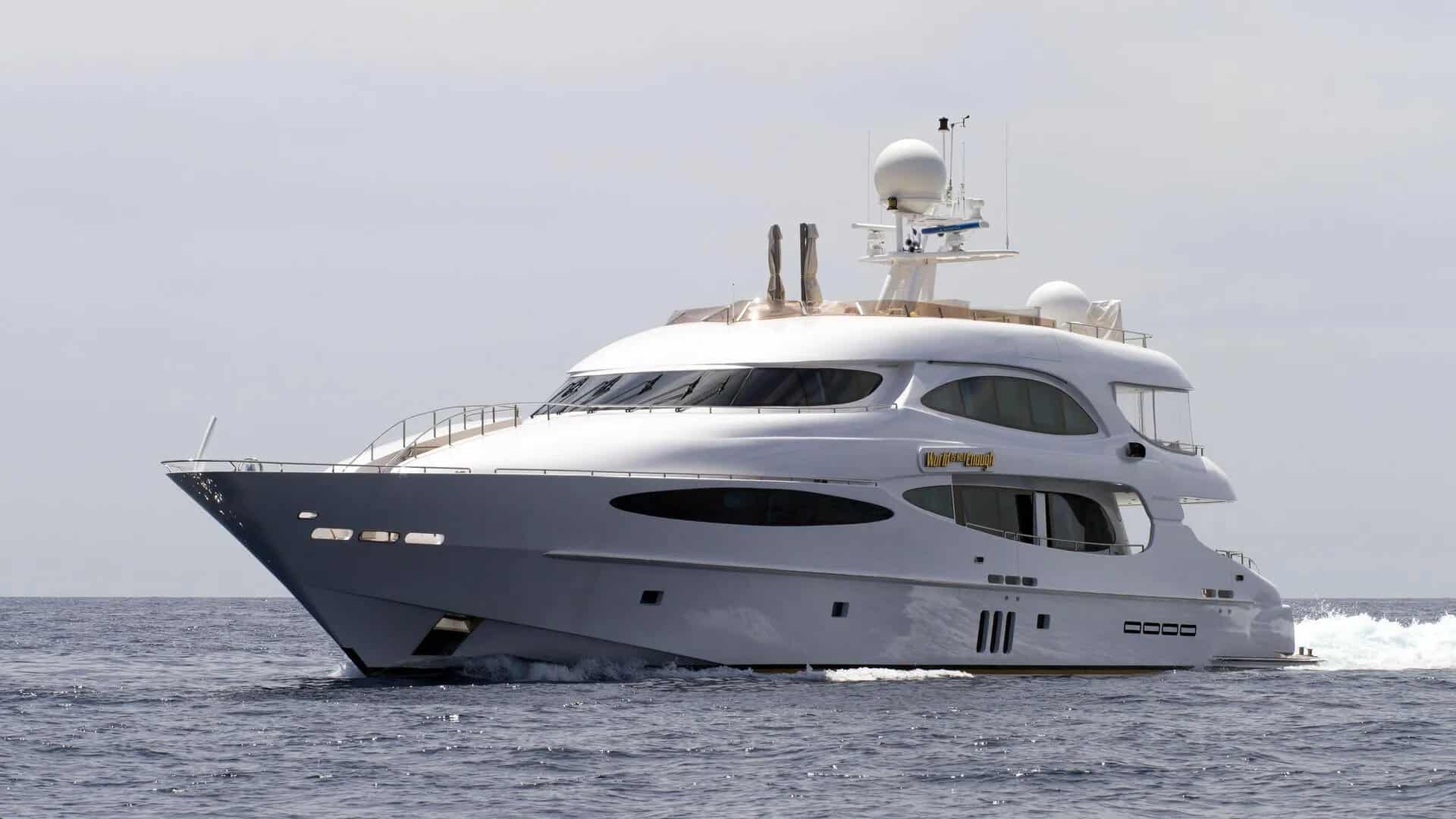
The Dutch superyacht World Is Not Enough, built in 2004 by Millenium Super Yachts, comes second place with a top speed of 67 knots. The vessel is powered by two Paxman diesel engines and two Lycoming gas turbines, which give an output of 20,600 hp, and a good 3800 nautical miles cruising range at a cruising speed of 10 knots.
With its 42.4 meters of luxury and beauty, World Is Not Enough can accommodate up to 10 guests and 7 crew members in five extravagant cabins, offering plenty of comfort and areas for relaxation. The vessel features formal dining spaces, indoor bar, and al fresco dining and lounge areas on all decks, for the ultimate pleasure away from civilization.
- 1. Foners – 70.1 knots
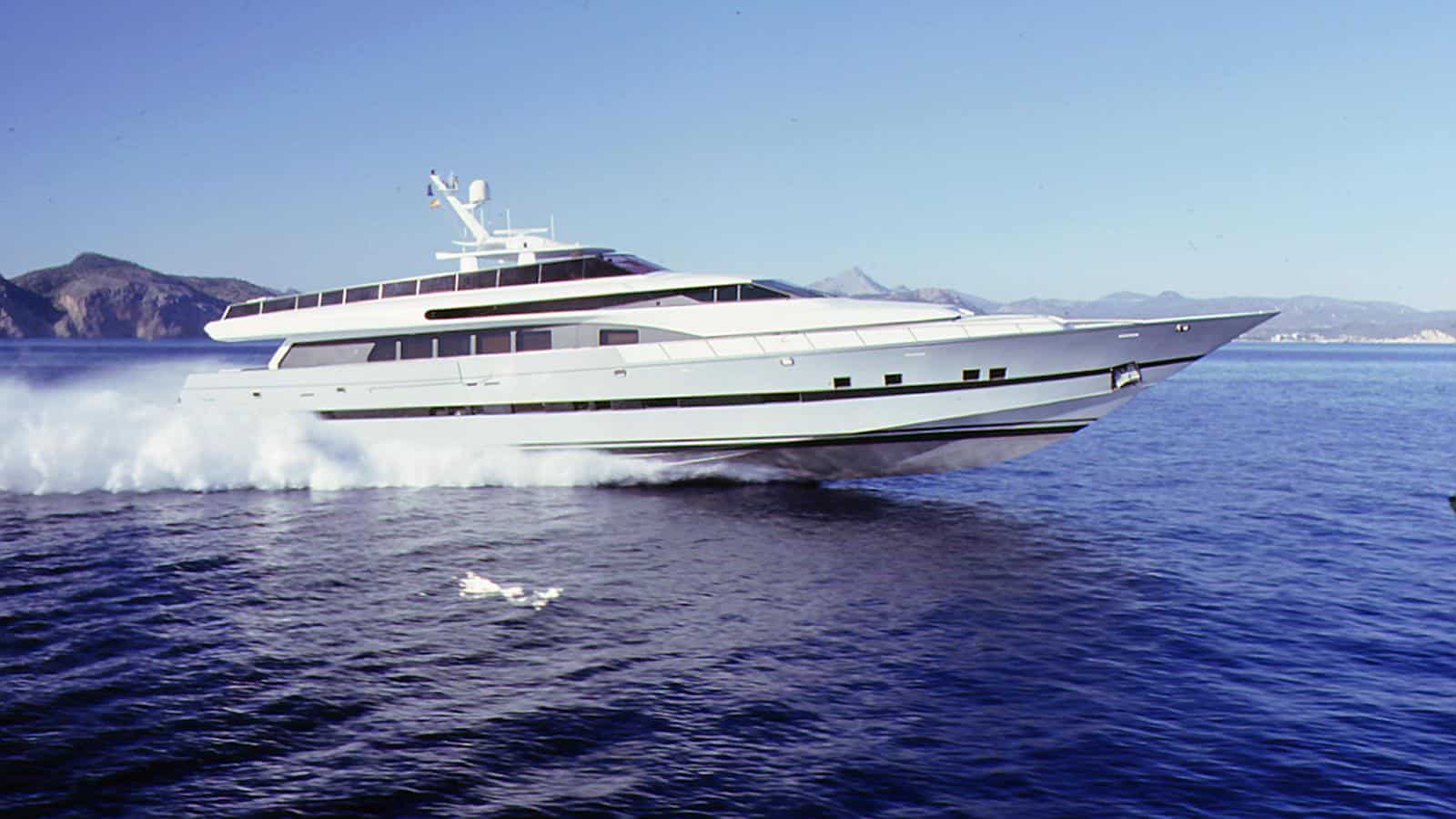
The Foners is currently the fastest super yacht in the world, with a 70.1 knots top speed, keeping the first spot since its delivery back in 2000. The power behind its top speed comes from two MAN engines and three Rolls Royce gas turbines, combining together to output a whooping 21,380 hp.
Her cruising speed is 12 knots, and allows her to reach a range of 1,800 nautical miles.
But of course speed isn’t everything here, as the eye is impressed a lot when stepping on board. Built by the Spanish shipyard Izar, Foners comes with splendid interiors, formal dining rooms, and plenty of space on the decks for al fresco dining. Its 6 crew and up to 8 guests can be accommodated on board, in luxurious cabins.
These are the fastest super yachts in the world, a competition that keeps on going, dominated for the last two decades by the Spanish vessel Foners.
As technology progresses, it will be interesting to see how it holds up against newer yachts.

About Alex Holmes
With over 10 years of experience in media and publishing, Alex is Luxatic's director of content, overlooking everything related to reviews, special features, buying guides, news briefs and pretty much all the other content that can be found on our website. Learn more about Luxatic's Editorial Process .
2 thoughts on “The 20 Fastest SuperYachts in the World”
Bolide by VICTORY DESIGN is now by far the fastest yacht; speeds up to 76 knots have been recorded by this 80ft full carbon pleasure Yacht, powered by three MAN V12 2000 diesel engines.
Leave a Comment
More from luxatic.

The 15 Biggest Planes in the World
By Vlad Craciun

The 10 Longest Range Private Jets in the World in 2023
By Victor Baker

The 15 Best Personal Submarines For Superyacht Owners
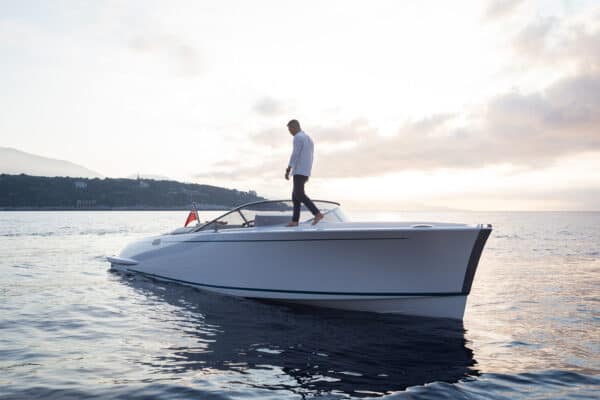
20 Best Electric Motorboats You Will Surely Love

The Longest & Shortest Runways in the World!
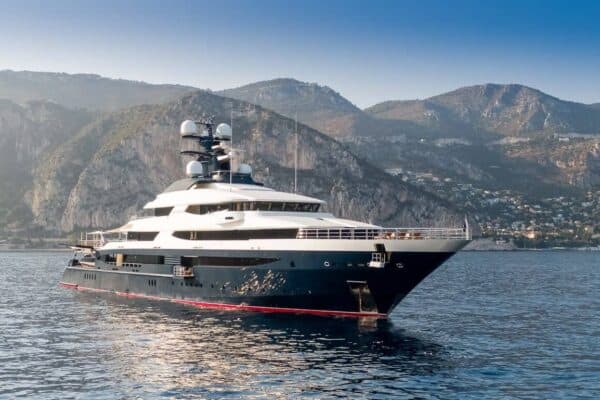
20 Largest Explorer Yachts in the World
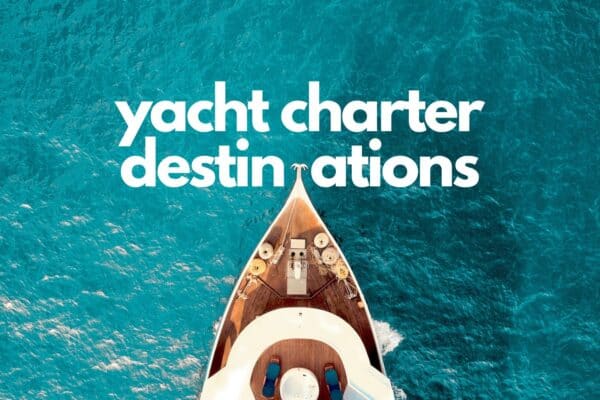
Sailing in Style: The World’s Most Beautiful Yacht Charter Destinations

24 Incredible Celebrity Yachts You Will Surely Love
By Adrian Prisca

These are The 15 Fastest Planes of All Time

The 20 Best Airlines in the World Right Now
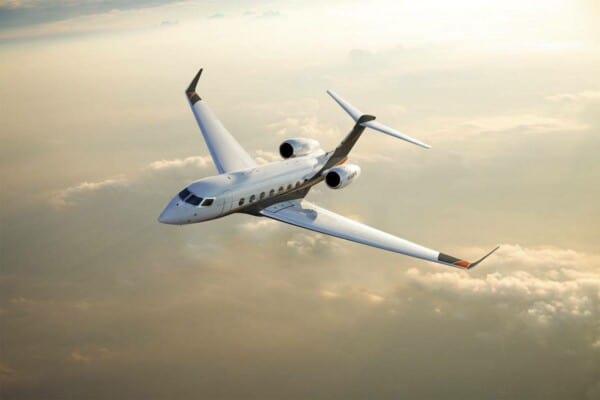
The 15 Best Small Planes That You Can Buy Right Now
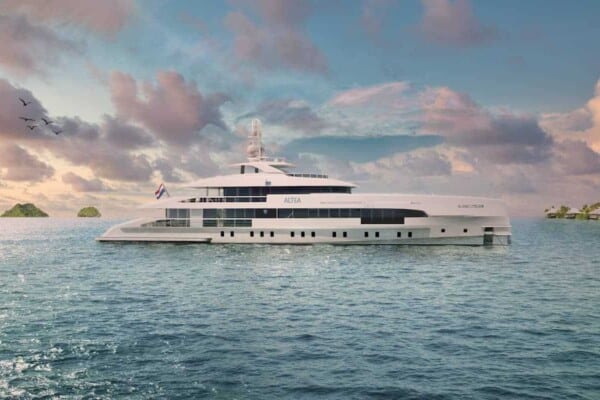
Best Luxury Yacht Brands: 25 Shipyards Which Build The Best Superyachts
By Brody Patterson
- North America
- South East Asia
- United Kingdom
- Global contacts
- Climate-tech centre
- Small modular reactors
- Micro-Reactor
- Digital Platforms
- Digital Twin
- The Aletheia Framework ®
- Sustainability
- Purchase Parts & Services
- Other Customers
- Aircraft Transitions
- Capable & Versatile
- RB211-524G/H & -T
- RB211-535E4
- Tay 620 / 650
- M250 turboshaft
- M250 turboprop
- Future products
- Access our testing capabilities
- Testbed facilities
- Net Zero for Future Combat Air Systems
- Developing the Next Generation
- Digital FIRST
- Energy Transition for Defence
- LibertyWorks
- Rolls-Royce LiftSystem®
- M250 Turboshaft
- Trent 700 MRTT
- M250 Turboprop
- T56 3.5 Enhancement
- Distributed Generation Systems
- MT30 Marine Gas Turbine
- AG9160 Generator Set
- AG9140 Generator Set
- MT7 Marine Gas Turbine
- Power Systems
- Naval Handling Systems
- Naval Support & Services
- TwinAlytix®
- Power Generation Solutions
- Governmental
- Power Systems Sustainability
- Our Electrical power & propulsion portfolio
- Our Capability
- Our Strategy
- Executive Team
- Corporate governance
- Where We Operate
- Advanced Manufacturing Research Centres
- Research and University Technology Centres
- Rolls-Royce Cybersecurity Technology Research Network
- Our Businesses
- Our History
- Our Heritage Centres
- Heritage Trust – Bristol
- Heritage Trust – Coventry and Ansty
- Heritage Trust – Derby and Hucknall
- Heritage Trust – Indianapolis
- Heritage Trust – Scottish branch
- Become a member
- Learn and explore
- Contact the Trust
- The Magazine
- News & Insights
- Members’ events
- R-RHT Documents
- Inventors & technology licensing
- Defence aerospace business team
- Defence team
- Corporate sustainability team
- Heritage team
- Helicopters team
- Pensions team
- Rolls-Royce no Brasil
- ロールス・ロイスについて
- country-landing-navigation
- Történeteink
- Támogatott kezdeményezések
- Nachrichten
- Geschichten
- Werde Teil des Teams in Dahlewitz bei Berlin
- Talent Community
- Direkteinstieg
- Praktikanten und Werkstudenten
- Karriere bei Rolls-Royce Electrical
- Schülerpraktika
- Tag der Ausbildung
- Engineering
- Manufacturing & supply chain
- Civil Aerospace
- Our approach
- Our community programmes
- MT30 함정용 가스터빈
- MT7 함정용 가스터빈
- 전기, 자동화 및 제어
- Our stories
- The wider South East Asia
- قطاع الطيران المدني
- أنظمة الطاقة
- رولز-رويس التكنولوجيا والفضاء
- رولز-رويس إس إم آر
- معامل بيانات آر2
- تواصلو معنا
- Our emissions footprint
- Decarbonising complex and critical systems
- Creating an enabling environment
- Materiality
- Ethics and compliance
- Engineering and innovation
- Operations and facilities
- Our Stakeholders
- Cyber Security
- Reporting approach
- Target progress
- Data charts
- Share price
- Analyst consensus
- Small Modular Reactors
- Why Rolls-Royce?
- 2023 Full Year Results
- Regulatory news
- Financial Results
- Annual Report 2023
- Annual Reports archive
- Financial calendar
- General Meetings 23 May 2024
- General Meeting archive
- Payments to shareholders
- Manage your shareholding
- Shareholder fraud warning
- Debt Securities
- Rights issue
- Investor contacts
- Company announcements
- Trade press releases
- Press releases
We develop and deliver complex power and propulsion solutions for safety-critical applications in the air, at sea and on land.
Our products and service packages enable our customers to connect people, societies, cultures and economies together.
Products & Services
We develop and deliver complex power and propulsion solutions.
For more than 100 years we have been at the forefront of innovation. Helping to power, protect and connect the modern world.
Create your future with us
Help us deliver better power for our changing world.
Doing more with less
We have a fundamental role in meeting the environmental and societal opportunities and challenges that the world faces.
Capital Markets Day 2023
We will announce new strategic and financial priorities on 28 November 2023 at our Capital Markets Day. We are inviting investors and stakeholders to hear our new priorities and objectives from our leadership team via a livestream.
Rolls-Royce announced Full Year Results on 22 February 2024.
View results
News centre
Updates and news from around the Rolls-Royce businesses.
Sign up to get the latest news
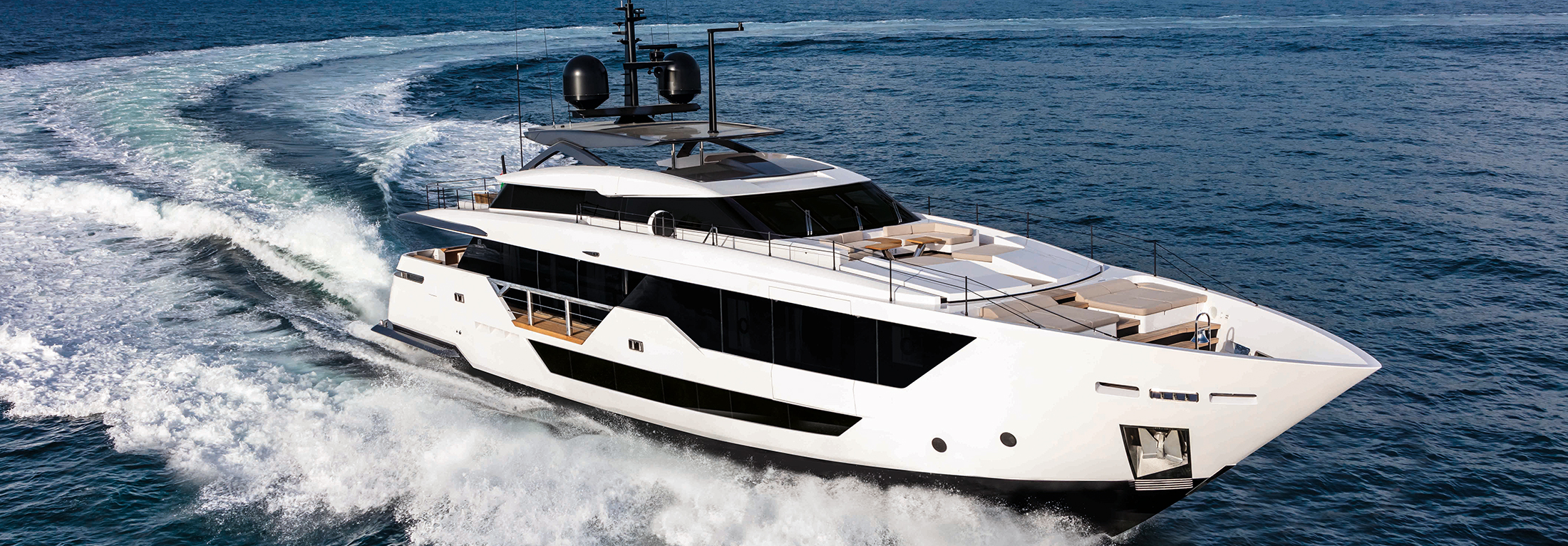
A new generation of yacht propulsion
In the harbour city of Ancona in the east of Italy, yacht-builder Ferretti Group is putting its Custom Line 106 yachts through their paces before handing them over to customers. Today, the first of these yachts to be powered by mtu Series 2000 units with IMO-3 approval is being tested on the water.
What’s particularly special about this yacht is the 16-cylinder engine equipped with integrated Selective Catalytic Reduction (SCR). Designed to substantially reduce nitrogen oxide emissions, it will allow yacht owners to enter emission-controlled areas (ECA zones) such as the coastal waters of Canada and the USA, as well as the Caribbean and the North and Baltic seas, without compromising the comfort and style customers expect. The yacht can reach a top speed of 26 knots (about 48 kilometres) per hour and boasts a luxury interior and exterior.

Proving the power of an eco-friendly solution
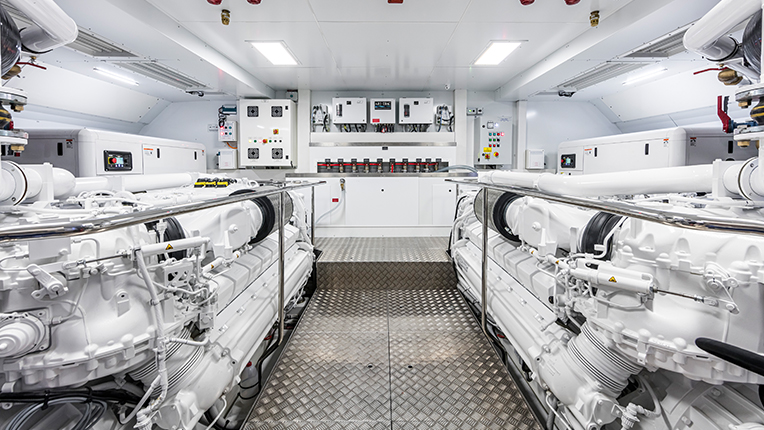
As part of the propulsion system’s rigorous testing process, engineers and measurement technicians from Ferretti Group Engineering Department and Rolls-Royce Power Systems observe how the yacht fares outside of laboratory conditions. The test crew onboard the yacht performs a series of manoeuvres while measurement technician Jan Leuthäußer from Rolls-Royce Power Systems watches the engine behaviour closely.
On the test stand, the mtu Series 2000 engines with IMO-3 approval performed just as well as previous IMO-2 units that didn’t have SCR. But at sea, technicians hope to confirm that the yacht’s turbochargers can handle the high exhaust gas backpressure caused not only by SCR but by the underwater exhausts typical of yachts. They’ll also be keeping an eye on the heat and noise levels produced by the SCR system.
“Of course, we're nervous,” admits Rüdiger Grau, technical lead on the development and testing of the mtu propulsion system at the Rolls-Royce Power Systems headquarters in Friedrichshafen. But relieved smiles from the Rolls-Royce test crew confirm that everything has gone to plan.
“In today's trials, the mtu 16V 2000 M97 unit showed us that it's every bit as powerful as its predecessor. And with SCR, a lot more eco-friendly,” comments Carsten Voigt, Project Manager at Rolls-Royce Power Systems.
The Custom Line Testing & Delivery Supervisor Captain and his crew are particularly impressed by the propulsion system's acoustic properties. With a well-insulated engine room, the engine’s noise and vibrations were hardly perceptible on deck. “It's so important for green engines to be able to offer our customers the carefree yachting experience they're used to,” he explained.
A hybridized future
Hybrid propulsion will also be part of the future scenario, with Rolls-Royce currently developing a fully integrated mtu hybrid solution delivering 1,432 kW per power train. The IMO-3-compliant system will comprise twin 12-cylinder mtu Series 2000 M97 diesel engines, electrical propulsion modules, gearbox, batteries, control and monitoring systems, further electronic components and an SCR system.
“Hybridizing propulsion is one possibility for making yachts greener. We're currently working on modular solution architectures in which hybrid systems will be combined with future technologies such as methanol engines, fuel cells and batteries – all with the aim of making yachts greener and more comfortable at the same time,” notes Tobias Kohl, Director Marine Engineering Applications at Rolls-Royce Power Systems.
Register for news and stories
Our Alert service delivers the latest press releases, stories and regulatory news directly to your mailbox.
- Sustainable power
Rolls-Royce develops and delivers complex power and propulsion solutions for safety-critical applications in the air, at sea and on land.
© Rolls-Royce plc 2024. All rights reserved.
© Rolls-Royce plc . All rights reserved.
- Products & Services
- Country sites
- Electrical Aviation
Vulnerability Reporting
Disclosure Policy
- Use of cookies
- Cookie Settings
- Legal information
- Data privacy
- Anti-slavery statement
- Accessibility

PREMIUM ENGINES AND PROPULSION SYSTEMS FOR
SUPERYACHTS
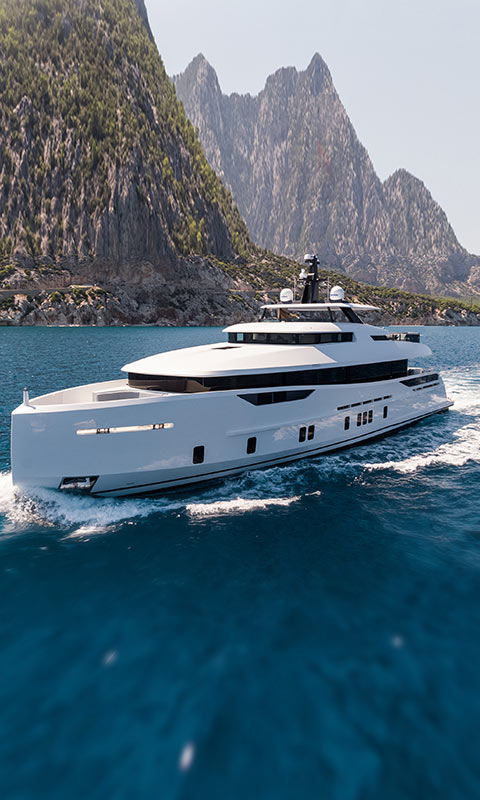
High-powered diesel propulsion systems for superyachts
With a rich legacy spanning over a century, Yanmar’s commitment to innovation in diesel engines resonates in our bespoke propulsion systems for superyachts. We craft cutting-edge technology to ensure performance, efficiency, reliability, safety and environmental compliance. Our customized solutions align seamlessly with the most stringent requirements and wishes for operational excellence on the water.

Performance & Durability
Experience premium performance and power with Yanmar engines tailored for superyachts. Built to withstand rigorous demands, our marine engines deliver optimal thrust, exceptional fuel efficiency and durability.

Optimized TCO
Yanmar engines offer optimized Total Cost of Ownership through superior fuel efficiency, exceptional reliability and minimized maintenance. Ensuring cost-effective, high-quality propulsion solutions.
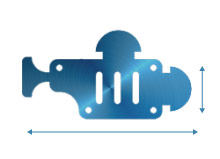
Customized Engine specs
With a customer-centric approach, our commitment goes beyond engine provision. Yanmar marine engines are customizable, aligning with aesthetic preferences and engine room details, ensuring bespoke solutions for distinctive superyacht designs.
Success stories
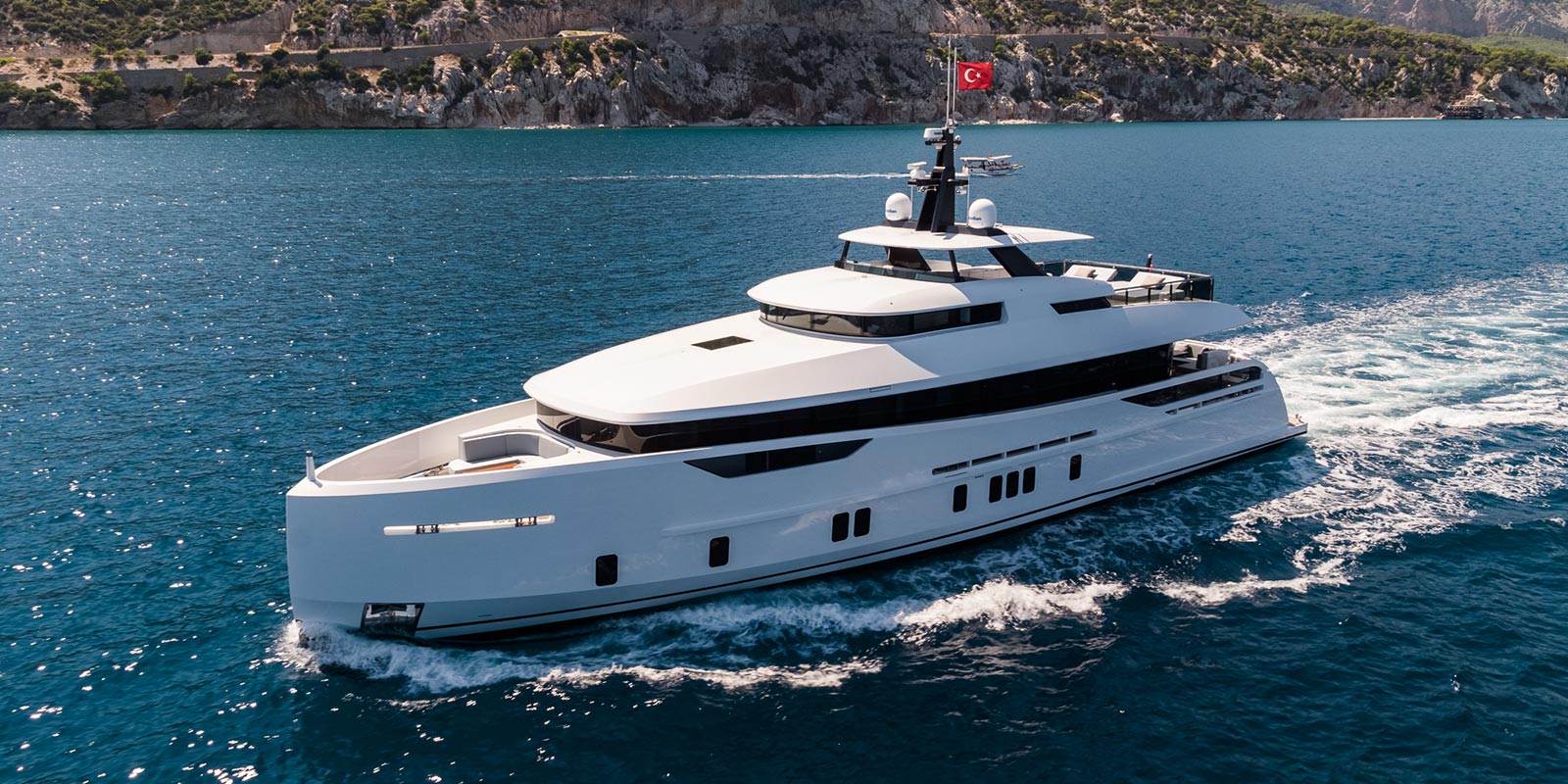
Virgen del Mar VI
The Virgen del Mar VI is a 30-meter superyacht designed by Omega Architects and built by Alia Yachts in 2018. It is powered by two Yanmar 6HYM-WET high-speed engines, producing 1400 mhp. These engines are known for their reliability, performance and efficiency, making them ideal for powering superyachts like the Virgen del Mar VI.
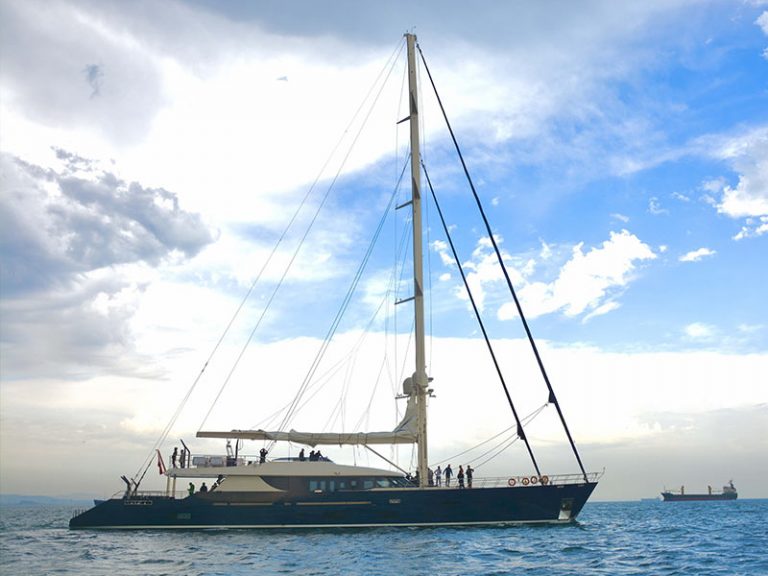
Two powerful and efficient Yanmar 6AYM-WGT-369 high-speed diesel engines, with a displacement of 20.4 liters and producing 911 horsepower each, effortlessly propel the L’Aguila II to impressive speeds while delivering remarkable fuel efficiency.
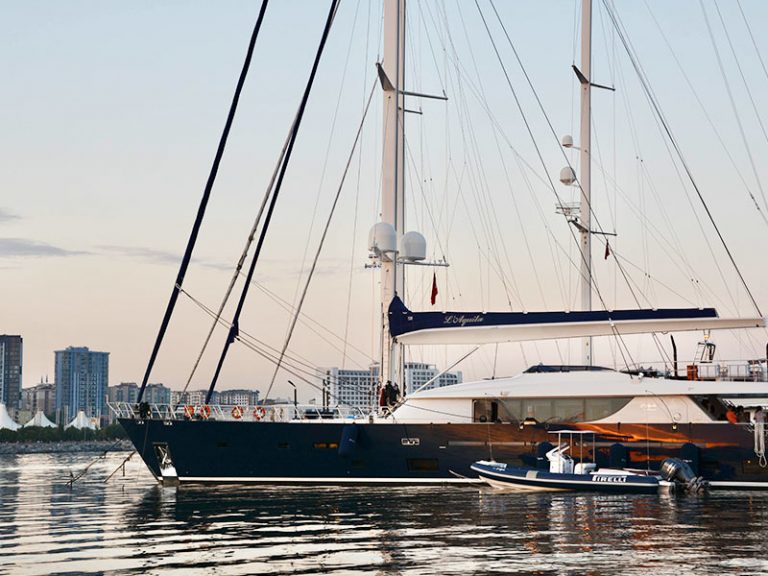
Superyacht L’Aguila III is powered by two Yanmar 6AYM-WGT high-speed engines, producing 1822 mhp. These engines are known for their reliability, performance and efficiency, making them ideal for powering sail yachts like the L’Aguila III.
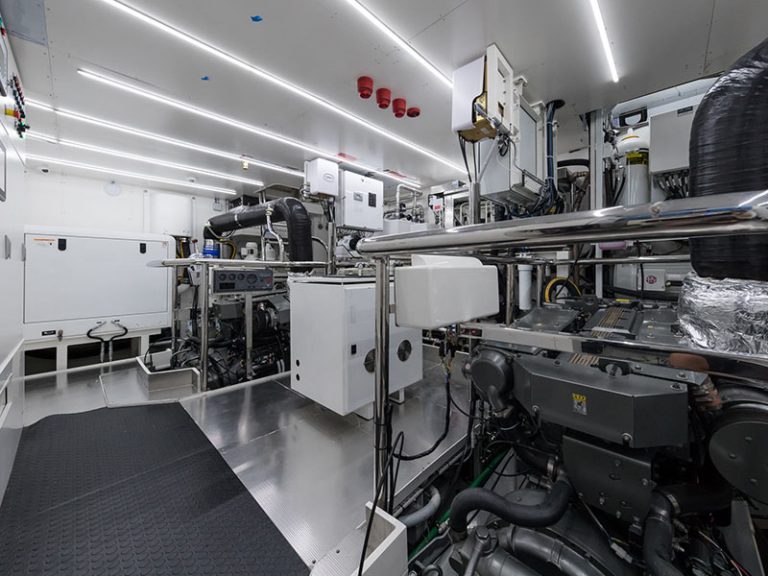
Partner up with Yanmar Marine for your next superyacht project. Experience unparalleled power with Yanmar engines, elevating your superyacht’s performance effortlessly.
Yanmar superyacht engines
Looking for a powerful superyacht partnership? Our marine experts design tailored propulsion and genset solutions.
Superyacht engine solutions
Yanmar offers an extensive range of high speed yacht engines, with a performance range from 385 kW to 1340 kW. Beyond superior power density, our engines go further — customized to match specific preferences. From enhancing aesthetics to tailored looks, each engine is meticulously adjusted to suit both unique specifications and the vessel’s architecture.
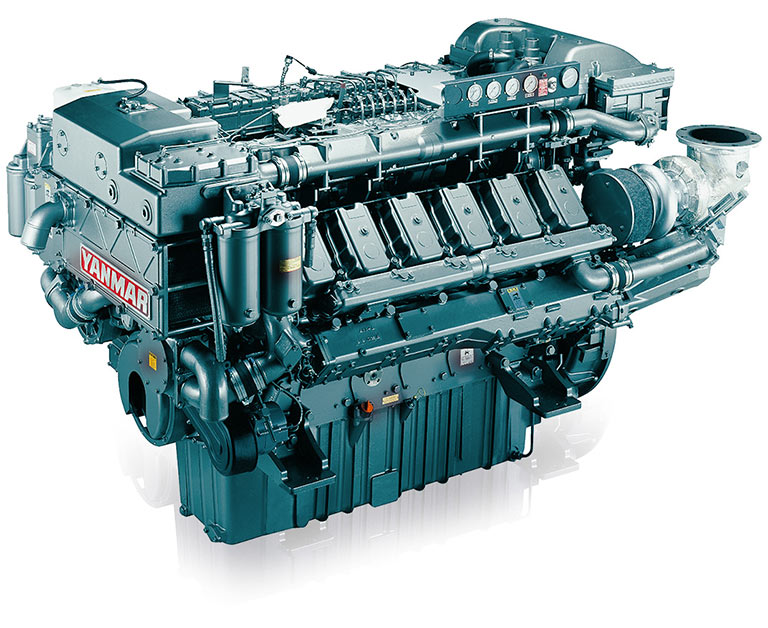
12AYE high-speed marine propulsion
Our 12AYE series high-speed marine engines are the pinnacle of power and elegance. With a power range of 1030 kW to 1340 kW, these engines are designed for the most demanding superyachts. 12AYE series engines offer exceptional power density, ensuring seamless navigation and efficiency. They are also incredibly reliable and durable, making them the perfect choice for long-distance voyages. In addition to their performance, 12AYE series engines are also known for their elegant design and high-quality construction. They are crafted to match the aesthetic desires of superyacht owners, creating a powerful and elegant space in the engine room. If you are looking for the best marine engines for your superyacht, then look no further than the Yanmar 12AYE series. With their power, reliability, efficiency and elegance, these series engines are the perfect choice for the most discerning superyacht owners.
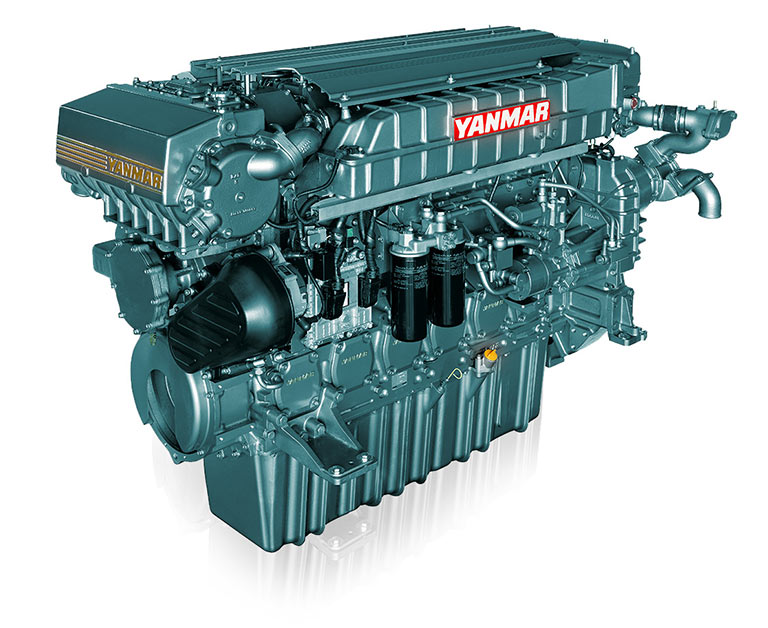
6AYE high-speed marine engines
Our 6AYE series high-speed marine engines are meticulously tailored for the high demands of superyacht design. With a power range of 485 kW to 749 kW, these engines provide outstanding power density, securing flawless navigation and efficiency. Despite their compact size, 6AYE series engines are incredibly powerful and reliable. They are designed to be flexible and easy to integrate into a variety of ship designs. And with their low emissions and high efficiency, 6AYE series engines are also environmentally friendly. But 6AYE series engines are more than just powerful and efficient machines. They are also crafted to match the aesthetic desires of superyacht owners. With their sleek design and elegant finish, 6AYE series engines blend perfectly into the engine room architecture, creating a powerful and elegant space. See how our 6AYE series can help you create the perfect superyacht.
Yanmar Marine is dedicated to a personalised approach and exacting attention to detail. Collaborating closely with superyacht designers, shipbuilders, yacht owners and owners representatives, we keenly comprehend their distinctive needs. This understanding guides our customization of engines and gensets, ensuring tailored solutions that perfectly match the unique specifications.
Empowering the superyachts industry
Yanmar proudly provides engines that surpass the standards set for yacht designers, builders and superyacht owners.
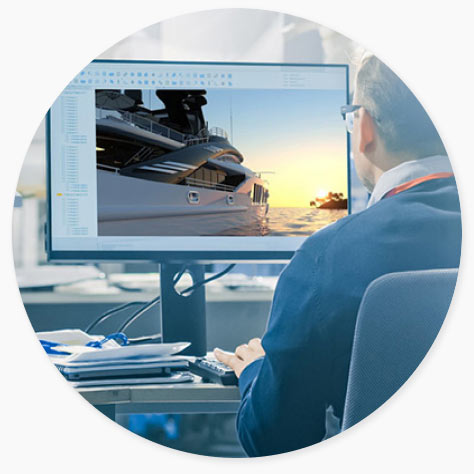
For superyacht designers
Yanmar collaborates closely with superyacht designers, providing bespoke power solutions and engines. Our partnership ensures precisely tailored and reliable engines that optimize performance, delivering exceptional solutions for the unique demands of luxury yachts, elevating efficiency and ensuring the satisfaction of discerning clientele.
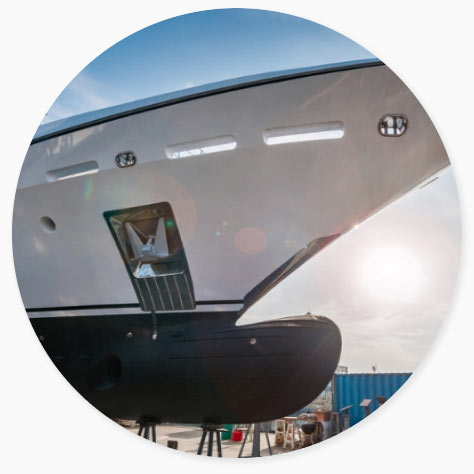
For yacht builders
Yanmar offers superyacht builders reliable, high-performance engines that seamlessly integrate into luxury yachts. Designed for optimized power and enhanced vessel capabilities, our engines ensure successful project completion and superior performance, meeting the highest standards of luxury and customer satisfaction.
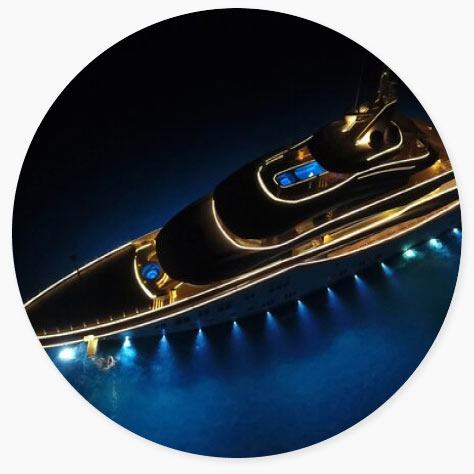
For yacht owners
Yanmar delivers dependable and efficient engine solutions to superyacht owners and their representatives. With increased reliability, improved fuel efficiency and a commitment to overall vessel excellence, our engines guarantee successful and luxurious yachting experiences, maximizing profitability for owners and operators.
At Yanmar Marine we value our partnership with the superyachts industry. Please contact Johnny Huisman for any enquiry.

Johnny Huisman
Senior Sales Engineer Superyachts Yanmar Commercial Marine Europe Mobile: +31 (0)6 2521 7538
Connect with us
Contact form.

By SuperyachtNews 13 Sep 2023
Rolls-Royce deploys biofuel engines
The series 2000 and 4000 mtu engines for yachts have been approved for release by the engine specialists….
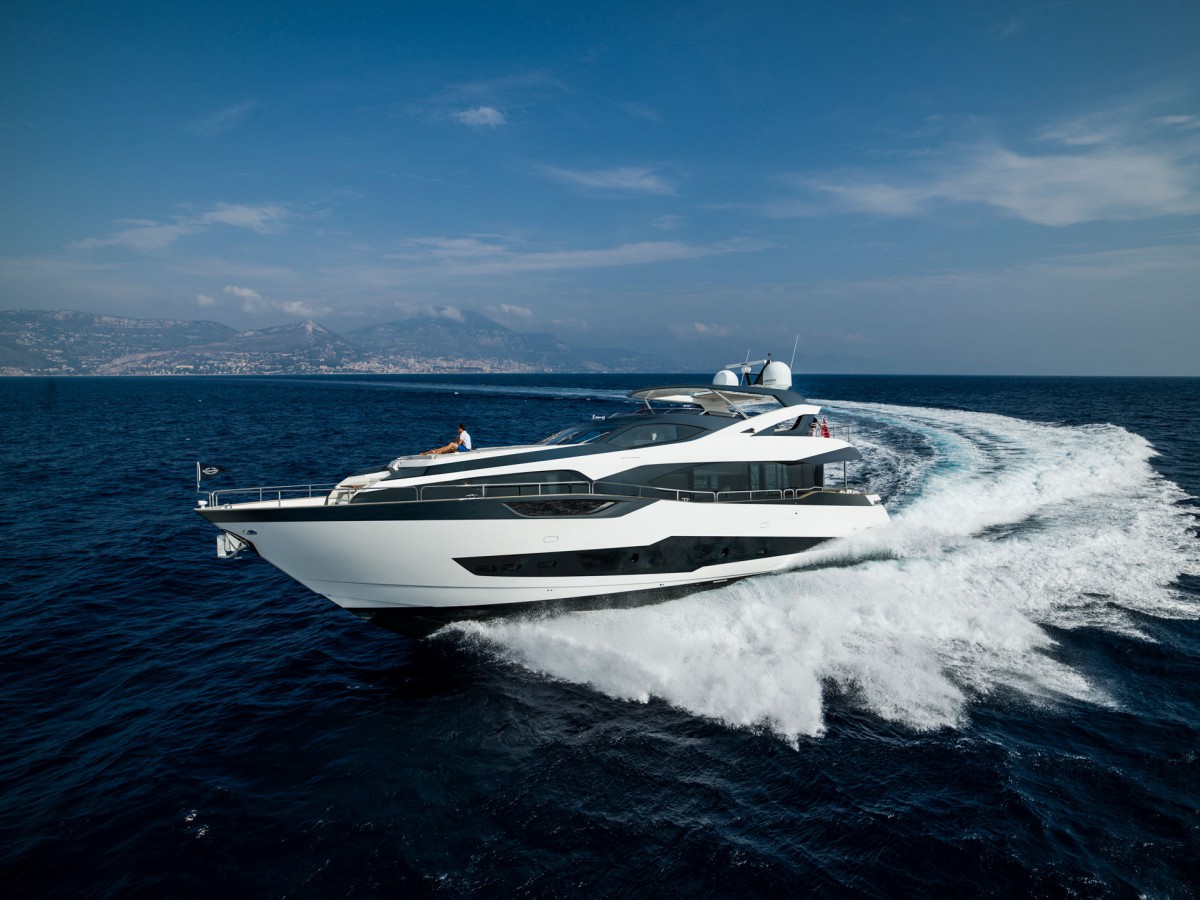
Rolls-Royce has released its two new superyacht engines capable of using synthetic diesel fuels – the Series 2000 and 4000 mtu. These fuels include BtL (Biomass to Liquid), HVO (Hydrotreated Vegetable Oil) and PtL (Power to Liquid) such as e-diesel, all of which can replace conventional fossil-based diesel fuel in these engines without any adjustments.
“We currently see renewable diesel (HVO) as a very valuable sustainable solution because the fuel is already available and offers some benefits to our yacht customers,” says Denise Kurtulus, vice president, Global Marine, Rolls-Royce Power Systems .
According to Kurtulus, HVO in the mtu engines significantly reduces particulate emissions by at least 40% and nitrogen oxide emissions by up to 8%. Depending on the production process and feedstock, there is also a decrease in CO2 emissions of up to 90% when compared to fossil diesel from well to wake.
“When running our mtu yacht engines on HVO, yacht owners benefit from a significantly reduced carbon footprint while continuing to enjoy best-in-class performance and experience quiet operation with further reduced soot emissions,” adds Kurtulus.
HVO fuel is produced from renewable raw materials, partly from waste, so its production, transport and combustion emit an equal amount of greenhouse gases that were absorbed by the plants during the growth of the biomass. As it is also a second-generation biofuel, it doesn’t use biomass that was created purely for fuel production, meaning it does not compete with crops that are used to produce food.
Meros Yachtsharing, a Spanish co-ownership firm, has tested HVO with its 28m Sunseeker Blue Infinity One (pictured). Delivered earlier this year and powered by two 12-cylinder mtu Series 2000 M96X engines, the vessel has completed 7 refuels across France and Spain already.
“After completing the 350-mile route from Mallorca to Monaco in May 2023, fuel efficiency, in terms of the fueled volume, has dropped slightly, but the yacht’s overall performance is no different than when using conventional fossil fuels,” says Captain Carlos Julia Dalmau of Blue Infinity One . “In addition, HVO operates at lower temperatures, resulting in lower engine noise and significantly less particulate matter and exhaust odour.” The cleanliness of the yacht has improved significantly, making maintenance and servicing much easier to manage, he adds.
Rolls-Royce will showcase its sustainable propulsion solutions and its expanded yacht portfolio From Bridge to Propeller , which includes bridge solutions, at the Cannes Yachting Festival and Monaco Yacht Show later this month.
Profile links
MTU - A Rolls-Royce Solution
Join the discussion
To post comments please Sign in or Register
When commenting please follow our house rules
Click here to become part of The Superyacht Group community, and join us in our mission to make this industry accessible to all, and prosperous for the long-term. We are offering access to the superyacht industry’s most comprehensive and longstanding archive of business-critical information, as well as a comprehensive, real-time superyacht fleet database, for just £10 per month, because we are One Industry with One Mission. Sign up here .
Related news
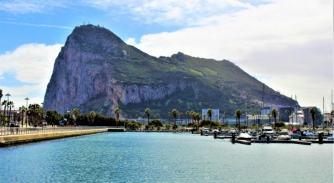
Peninsula to supply biofuel in Gibraltar
Chris Warde details how greater transparency within the biofuel supply chains will help decarbonise yachting in the Med
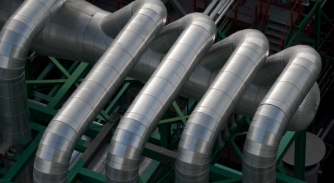
Biofuel plant to open in Spain
Mediterranean capacity of 2nd gen and advanced biofuels to increase with petrochemical giant Repsol to start production at Cartagena facility
.jpg)
Rolls-Royce and Lürssen announce sustainability projects at MYS
Rolls-Royce made two announcements at MYS regarding its role in a greener future for the Yachting Industry
8 months ago
2 years ago
Sign up to the SuperyachtNews Bulletin
Receive unrivalled market intelligence, weekly headlines and the most relevant and insightful journalism directly to your inbox.
Sign up to the SuperyachtNews Bulletin
The superyachtnews app.

Follow us on
Media Pack Request
Please select exactly what you would like to receive from us by ticking the boxes below:
SuperyachtNews.com
Register to comment
- Cars, Jets & Yachts
The Best Hybrid Superyachts in the World
These eco-conscious vessels offer all the luxury of your typical superyacht.
By Emma Al-Mousawi

Hybrid power is seen as one of the most exciting innovations in the yachting world, with more superyacht owners demanding their vessels leave a smaller carbon footprint.
It is somewhat disputed quite how long hybrid superyachts have been around. Some would argue that Royal Huisman’s Etheral was the first superyacht to pioneer the use of hybrid technology when she launched in 2008. Others would say that hybrid power in fact arrived seven years later in the form of Feadships’s Savannah, featured below.
What can be agreed is that the hybrid superyacht is here to stay, and since both Etheral and Savannah hit the water, numerous luxury shipbuilders have followed suit. But what actually is a hybrid superyacht? Bjorn Moonen of Ghost Yachts offers a straightforward explanation in Superyacht News. He said: “A hybrid yacht is basically a yacht that can be propelled by two different energy sources. Most commonly these are a combination of diesel and electric propulsion systems”. As in cars, this system is infinitely greener thanks to the reduction in fossil fuel usage.
As well as hybrid power, these forward-thinking owners and their engineering teams often incorporate the very latest green technology into their designs – such as solar power and wastewater recycling system – limiting their impact that one step further. At Elite Traveler we have shortlisted some of the very best hybrid superyachts on the water today.
[See also: Meet the Elite Traveler Eco Superyacht by Heesen]
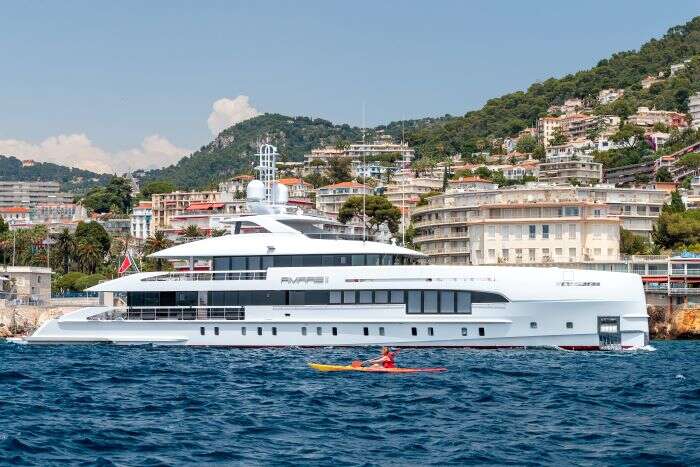
Amare II can can reach speeds of 17.2 knots / ©Dick Holthuis
Builder: Heesen Year of build: 2020 LOA: 164ft Number of guests: 12 Number of crew: 9

Sea Change: The Sunreef 88 Ultima Yacht
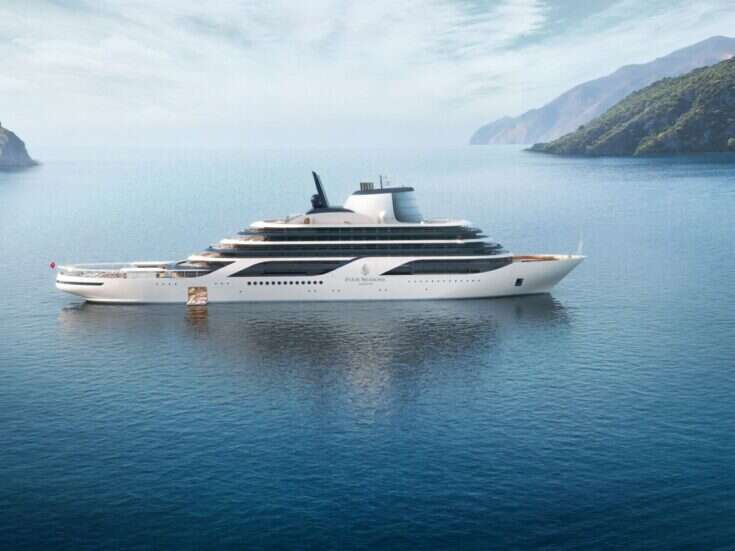
Four Seasons Yachts Announces its First Luxury Itineraries
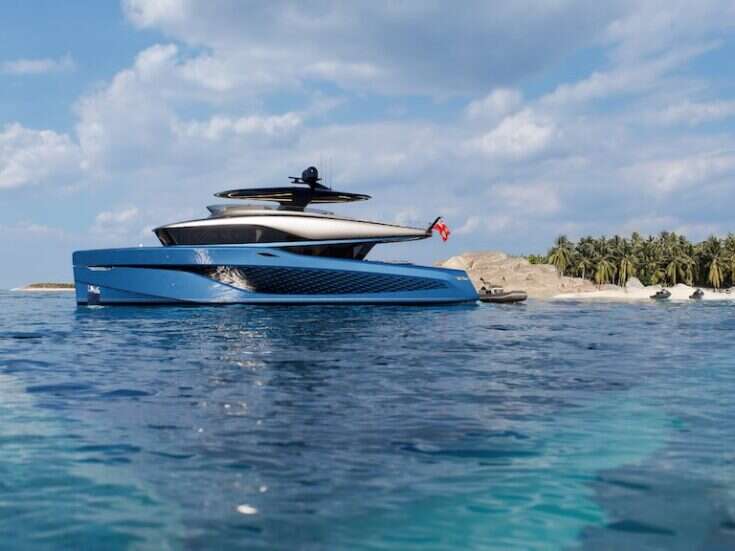
Sialia Yachts Launches Advanced Electric Explorer Yacht
Delivered in June 2020, Amare II is one of the newest hybrid superyachts to hit the water. Custom built by Dutch shipyard Heesen, her sea trials were completed during the height of lockdown which Heesen described as “challenging” but her delivery date was kept on track so she could enjoy her first summer cruising the Mediterranean in 2020.
Thanks to her lightweight aluminum Fast Displacement Hull, which was devised by naval architects Van Oossanen and engineered by Heesen’s in-house team of experts , she offers the luxury of silent cruising coupled with frugal fuel consumption. In diesel mode, Amare II can reach speeds of 17.2 knots while in silent mode she can travel at 10.2 knots.
[See also: Twenty for 20: Innovative Yachts of the 21st Century]
Content from our partners

W New York – Times Square: “We Do Things Differently”
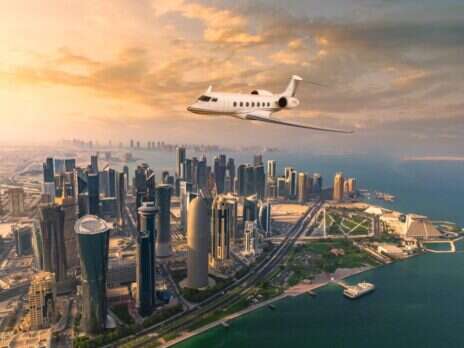
The Finest Destinations to Fly Private with Qatar Executive

A Weekend Travel Guide to Austin, Texas
Her sleek exterior lines are courtesy of Omega architects who also penned Heesen’s first hybrid superyacht Home. Her interiors are yet to be seen publicly but are said to feature soft pastel tones by Monégasque studio Sabrina Monte-Carlo and fine furnishings by the Italian designer Cristiano Gatto.

Artefact set sail on her maiden voyage in 2020 / ©Francisco Martinez
Builder: Nobiskrug Year of build: 2020 LOA: 262.5ft Number of guests: 12 Number of crew: 24
This hi-tech head-turner built by German shipyard Nobiskrug also took her maiden voyage in 2020. Nobiskrug states that the goal in her design and build was to demonstrate that “ beautiful man-made objects can complement and celebrate the natural environment with minimal impact.” Have her builders and designers achieved what they set out to?
The facts speak for themselves. Artefact has some of the lowest emissions of any superyacht and is one of the only ones to meet the International Maritime Organization’s Tier III emissions regulations. Utilizing the very latest green technology she features solar panels and a battery storage system that enable the vessel to reduce the use of its combustible engines, as well as a wastewater recycling system and a silent hybrid propulsion system that can hold position without dropping anchor to protect the sensitive seafloor.
It’s not just Artefact’s green credentials that are changing the game but also her avant-garde exterior design by naval architect Gregory C Marshall. Her multilevel glass wall and quirky curved windows are like nothing ever before her.
Black Pearl
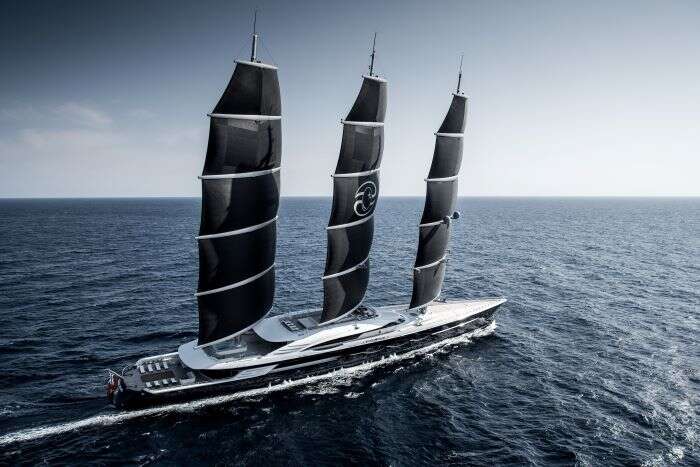
Oceanco say that Black Pearl capable of crossing the Atlantic without using any fuel / ©Tom Van Oossanen
Builder: Oceanco Year of build: 2018 LOA: 350ft Number of guests: 12 Number of crew: unknown
Oceanco’s Black Pearl is the world’s largest sailing yacht ( Sailing Yacht A below is larger but is a sail-assisted yacht) and is estimated to have cost in excess of $200m. The distinct vessel has achieved worldwide fame in the yachting world thanks to her innovative design and eco-credentials which have set a new industry standard.
Capable of crossing the Atlantic without using any fuel, Black Pearl is powered by a hybrid propulsion system that Oceanco designed in collaboration with consultancy BMT Nigel Gee. Of course, her other power source comes in the form of her towering 230ft DynaRig carbon masts which were designed by Dykstra Naval Architects and house 31,215 sq ft of sales. Harnessing wind propulsion couldn’t be easier as her sales can be set at the touch of a button in just seven minutes allowing for a much greener mode of travel than your average motor yacht.
Black Pearl’s interiors remain somewhat of a mystery but according to the Italian design studio Nuvolari Lenard who were responsible, the design embraces Louis XVI style (imagine elaborate wood carvings, opulent fabrics and gold touches) as well as some art deco influences.
[See also: Step Inside the Black Pearl Yacht]
Bravo Eugenia
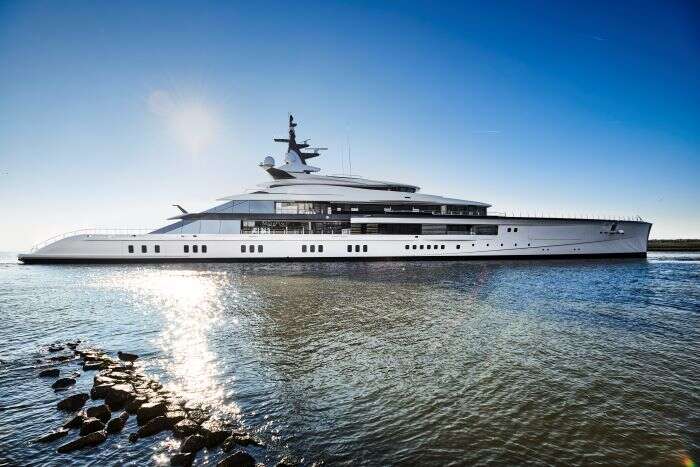
Bravo Eugenia uses around 30% less fuel consumption than her competitors / ©Francisco Martinez
Builder: Oceanco Year of build: 2018 LOA: 357ft Number of guests: 14 Number of crew: 30
Dallas Cowboys owner Jerry Jones’ Bravo Eugenia superyacht was the first Oceanco vessel to utilize an innovative LIFE design approach which was created with the input of Lateral Naval Architects. LIFE, which stands for lengthened, innovative, fuel-efficient and eco-friendly, harnesses intelligent naval architecture with these four principles in mind to achieve a harmonious balance between weight, power, technology and luxury living space.
By boosting Bravo Eugenia’s waterline length, engineers were able to reduce the overall need for propulsion power and could therefore install smaller engines. In fact, while most similar-sized superyachts would demand a two-level engine room, Bravo Eugenia ’s occupies just one, freeing up over 1,000 sq ft of living space (or more rooms for the vessel’s toy and tender collection).
The team also refined her hybrid propulsion system to give significantly better fuel efficiency – around 30% less fuel consumption than her competitors.
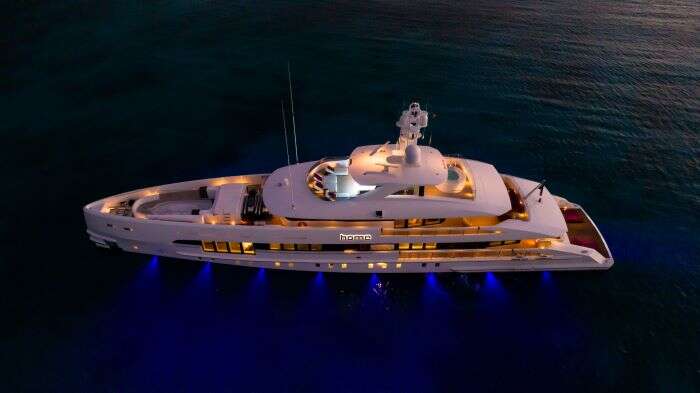
Home is Heesen’s first hybrid propulsion yacht / ©Jeff Brown
Builder: Heesen Year of build: 2017 LOA: 163.3ft Number of guests: 12 Number of crew: 9
Heesen’s first hybrid superyacht was also the first to benefit from Van Oossanen Naval Architects’ li ghtweight aluminum Fast Displacement Hull. Her innovative eco-credentials and cutting-edge design caused quite the stir in the industry; so much so that Home scooped three awards at the prestigious Monaco Yacht Show in 2017 as well as a World Super Award and a Boat International Design Award in 2018.
Able to seamlessly shift between her diesel engine to electric, Home offers a more efficient voyage with reduced vibration and noise making for a more comfortable cruise.
Available to charter from Burgess from $245,000 per week , Home’s Cristiano-Gatto-designed interiors are the epitome of relaxed luxury. The outdoors is invited in through floor-to-ceiling glass windows which flood her beach-club-style VIP cabin and living areas with natural light.
Sailing Yacht A
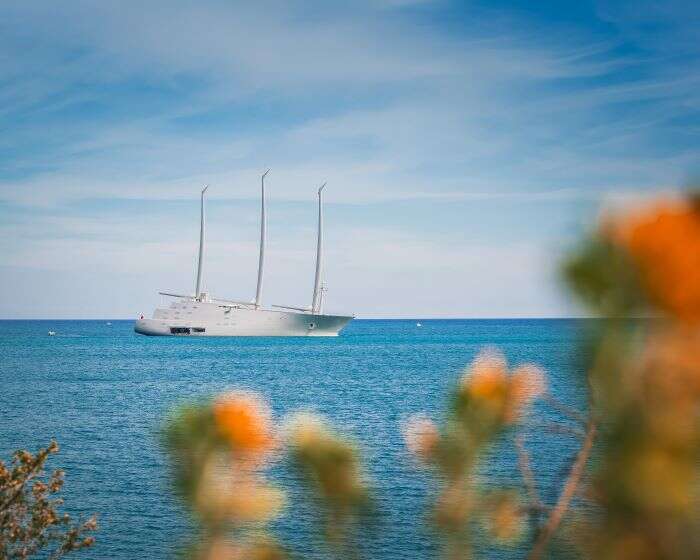
Sailing Yacht A’s exterior and interior were designed by Philippe Starck / ©I.Puiatti
Builder: Nobiskrug Year of build: 2017 LOA: 468.5ft Number of guests: 14 Number of crew: 35
At an enormous 468.5ft, Sailing Yacht A is the largest sail-assisted yacht in the world. Her lustrous futuristic exterior perfectly complements the forward-thinking engineering that powers this groundbreaking vessel. Sporting a hybrid diesel-electric propulsion system and advanced navigation technology Sailing Yacht A is reported to have cost in excess of $400 million.
Her mainmast towers designed by Dykstra Naval Architects – responsible for Black Pearls’ and The Maltese Falcon’s masts – are the largest carbon masts in the world and stand 328ft above the waterline, taller than London’s Big Ben.
The striking hybrid superyacht’s interior and exterior were designed by the renowned Phillippe Starck and feature near-invisible windows enabling her streamlined appearance. This eight-deck superyacht is said to host a plethora of incredible amenities including a glass observation pod, a helipad, huge swimming pool and a submarine.

Savannah was built by Dutch shipyard Feadship/ ©Feadship
Builder: Feadship Year of build: 2015 LOA: 273.1 ft Number of guests: 12 Number of crew: 26
The multi-award-winning Savannah is widely regarded as the world’s first hybrid superyacht. Combining a single diesel engine with a pioneering electro-mechanical propulsion platform and streamlined hull, she is a true innovator.
Built by Dutch shipyard Feadship, both her metallic exterior and sophisticated interior were designed by Paris-based Cristina Gherardi Design. The main aft deck has the effect of almost emerging from the water’s edge, with steps and platforms leading to a spacious beach club and living area. An outdoor 33ft pool, underwater lounge and a library are just some of the amenities that can be enjoyed onboard by those who wish to charter her, with a week-long charter costing approximately $1.2 million.
[See also: Style and Sustainability: The New Sunreed 80 Eco Catamaran]


Emma Al-Mousawi
Latest in luxury, the explorer.
Thank you for subscribing to Elite Traveler.

The global authority in superyachting
- NEWSLETTERS
- Yachts Home
- The Superyacht Directory
- Yacht Reports
- Brokerage News
- The largest yachts in the world
- The Register
- Yacht Advice
- Yacht Design
- 12m to 24m yachts
- Monaco Yacht Show
- Builder Directory
- Designer Directory
- Interior Design Directory
- Naval Architect Directory
- Yachts for sale home
- Motor yachts
- Sailing yachts
- Explorer yachts
- Classic yachts
- Sale Broker Directory
- Charter Home
- Yachts for Charter
- Charter Destinations
- Charter Broker Directory
- Destinations Home
- Mediterranean
- South Pacific
- Rest of the World
- Boat Life Home
- Owners' Experiences
- Interiors Suppliers
- Owners' Club
- Captains' Club
- BOAT Showcase
- Boat Presents
- Events Home
- World Superyacht Awards
- Superyacht Design Festival
- Design and Innovation Awards
- Young Designer of the Year Award
- Artistry and Craft Awards
- Explorer Yachts Summit
- Ocean Talks
- The Ocean Awards
- BOAT Connect
- Between the bays
- Golf Invitational
- Boat Pro Home
- Pricing Plan
- Superyacht Insight
- Product Features
- Premium Content
- Testimonials
- Global Order Book
- Tenders & Equipment

Future fuels: Is the industry doing enough and what are the alternatives?
The yachting industry has got by with conservative tweaks to diesel-based engines for years, but now, time is up. As the industry prepares to come together at the 2022 Superyacht Design Festival to discuss potential solutions, BOAT outlines the options facing builders and owners today in the face of tough new emissions targets...
The yachting industry needs a revolution. It’s currently attached to the status quo – twin diesel engines, shafts and propellers (and variations thereof) are still the norm. Why? Diesel is a widely available fuel that packs the most bang for its buck, and private yachts use some of the “cleanest” diesel available in finely tuned engines, is a typical answer. Is it true? Essentially yes, says Martin Richter, Ship Type Expert, Yacht, for classification society DNV GL. “These are cleaner solutions and state-of-the-art engines – [although] they still burn conventional fossil fuels.”
But better naval architecture, increased efficiency and finely tuned engines won’t suffice to meet decarbonisation goals. “To comply with the IMO’s level of emissions, improving efficiency will not be enough. We will have to go through a propulsion revolution, which means new fuels,” says Lorenzo Pollicardo, technical & environmental director for the Superyacht Builders Association (SYBAss).
Among problematic emissions, including carbon dioxide (CO2) and sulphur oxides (SOx), nitrogen oxides (NOx) have been in the forefront in recent years because of a 2021 deadline that mandated the maritime industry come up with solutions to reduce NOx output.
“Yachts don’t emit a lot of sulphur, but that leaves other emissions,” says Robert van Tol, executive director of the Water Revolution Foundation, which is attempting to provide the first comprehensive guide that defines the yachting sector’s environmental impact. “The SCR [selective catalytic reduction] system – which injects a urea solution into exhaust – is trying to tackle NOx.” However, it’s bulky, cumbersome and only effective at high temperatures, so the industry is looking for other solutions that will help meet regulations without reinventing the engine room.
Another reason for conservative thinking is safety. “Naval architects are risk-averse,” says Jorden Kemper, founding partner at Zero Emission Advisors, a consulting company based in San Francisco that advises industries on hydrogen solutions. “[They are about] safety engineering and compliance.” And they are not the only ones. Classification societies, brokers and buyers also gravitate toward proven solutions. Finally, for builders and shipyards it makes sense financially to choose incremental improvements (for example, better engines, variable-speed generators, heat recovery systems, batteries for peak shaving or better stabilisers) over radical changes. “Manufacturers have billions of dollars-worth of production lines based on the conventional system. Will they simply dump their investments? I don’t think so,” offers a naval architect and engineer working in Turkey.
- What the IMO's new cyber security requirements mean for superyachts
Improvements are possible, including in the yacht’s most fundamental characteristic, its naval architecture – especially since computational fluid dynamics (CFD) analysis has made the modelling of hulls quicker and more affordable. Take the Hull Vane, an underwater appendage that acts a bit like a spoiler on a car to improve efficiency. Heesen’s first installation on 42-metre Alive (now Ares )yielded a 20 per cent fuel saving in “the yacht’s useful speed range”. This result is consistent with a case study on a 52-metre offshore patrol boat retrofit. Fuel consumption was reduced by 18 to 27 per cent, depending on speed. Increased stability and less fuel also mean fewer emissions (and increased comfort).
Fuel for thought
Although seldom discussed in yachting circles, bio and synthetic fuels offer great benefits because they work with current combustion engines and have far fewer emissions. In the US, Gevo makes fuel, essentially, from carbohydrates. It currently focuses on jet fuel and gasoline (Isobutanol made from corn), which the National Marine Manufacturers Association (NMMA) has endorsed for use as a blend in boat engines in the US. If the demand is there, Gevo can also produce biodiesel for maritime use.
Rolls-Royce (which owns engine maker MTU) sees these types of fuels as a good transition solution. “Short- to medium-term options are synthetic diesel fuels, [such as] the second generation of bio-based fuel like HVOs [hydrotreated vegetable oils], and in the longer term we believe there will be a transition to e-fuels [synthetic fuels produced by electrolysis],” says Daniel Chatterjee, head of Exhaust Gas After-treatment & Green & High-Tech Programme at Rolls-Royce Power Systems. “Our modelling sees that the major take-up for renewable fuels made from electricity will be after 2030. Until then, we will see those bio-based fuels.” Because engines can work with synthetic and conventional diesel indiscriminately, availability will not be a problem, even for long-distance cruises, making them an attractive intermediate solution.
Why won’t incremental changes suffice?
For better or worse, large yachts are considered part of the maritime community and have to comply with international conventions, says Pollicardo. Driving change in the maritime world is the IMO’s 2018 adoption of greenhouse gas emission reduction targets. “The real objective is to reduce the total greenhouse gas emissions by at least 50 per cent by 2050,” he says, with full decarbonisation by 2100.
Combustion engines have had more than 100 years of refinements and are very good at converting fuel into mechanical energy. “[But] when you are at 40, 45, 50 per cent (thermal) efficiency, you reach a point where you can’t make the engine significantly more efficient,” says Kristian Holmefjord, executive vice president and project director–fuel cells for Corvus Energy.
IMO’s 2018 resolution also implemented an Energy Efficiency Design Index (EEDI) that requires a minimum energy efficiency level per capacity mile for new ships, and Pollicardo says it’s essential for the yachting industry to come up with facts and figures relevant to private yachts to help tailor these regulations. For instance, ships have regular routes and predictable speed and behaviour, while SYBAss has calculated that yachts operate an average of 400 to 500 hours a year. This means that solutions devised for the shipping industry will not necessarily translate to yachts, and vice versa. Besides, “There is no comparison between the economic model of yachts and the shipping industry,” says Laurent Perignon, who advises Energy Observer Developments (EODev), an R&D firm working on speeding up the energy transition.
There is also the matter of public image. Who wants to be seen as having wanton disregard for a global environmental problem? Yacht owners don’t. Lennart Pundt, head of project development for Lürssen , sees a parallel between new designs that place the lifestyle close to the water and an “increased awareness and care about environmental responsibility. The mindset is changing,” he says.
What are the current options?
The time has not yet come to ditch the combustion engine. It will play a role for up to 50 years, Homelfjord says, but a transition is happening with many taking a look at re-emerging fuels (for instance, hydrogen, ammonia or synthetic diesel) and new power conversion solutions. A common thread is electrification through fuel cell and battery technologies.
“There are currently more than 500 hybrid or purely electric ships of all kinds either in service or under construction. What is truly impressive about this number is the fact that it has grown from practically zero over as little as five years,” says DNV’s Richter.
Whether going hybrid is currently a “green” solution is hotly debated and it’s nearly impossible to quantify fuel (and emissions) savings because yachts have such different operating profiles. “We do not have any numbers to show that diesel-electric hybrid systems are better or worse in terms of their fuel efficiency,” Richter says, “but they have a number of advantages over conventional engines” – reduced noise and increased comfort.
The best way to do that would be to equip two identical yachts with hybrid and conventional propulsion systems, access their data, and compare their fuel consumption over time. Tankoa comes close to this scenario, having equipped its 50-metre aluminium platform with both conventional and hybrid systems.
The shipyard worked with E-Motion on the parallel hybrid system installed on the World Superyacht Award-winning 50-metre Bintador . The set-up combines two diesel engines (with maximum rated power of 895kW), generators and electric engines. Good management is key of course, but the shipyard’s technical director, Andrea Parodi, says that in the range of 15 to 17 knots and using the shaft alternator option (diesel engines on, generators off and electric motors producing electricity) it’s realistic to expect to save 15 to 20 per cent in fuel consumption and extend the range from 4,000 to 4,400 nautical miles. This platform, he says, is well suited to hybrid because “the hull is very efficient in low-speed conditions, seven to 11 knots, and does not need a lot of power to start moving.” It takes two small generators (500kW) and electric motors to run the yacht up to 11 knots and keep all the lights on. An in-build hybrid yacht at Tankoa will also have a zero-emission mode.
With the introduction of improvements such as variable-speed generators and energy-dense batteries, the range of potential applications has grown significantly since 2006 when the founder of E-Motion, Michele Maggi, worked with Ferretti on the first hybrid system to be fitted on a motor yacht (a 23-metre Mochi Craft). Maggi sees perfect applications on everything from 30-metre planing yachts to sportfishers, which can charge batteries while heading to their fishing grounds, then trawl for hours on electric power, with savings of up to 30 per cent in fuel and emissions, he says. And thanks to the fast progress in batteries, it’s only going to improve. E-Motion currently works with shipyards in the US and Italy, including Azimut-Benetti, for whom it is developing hybrid solutions for several models in the builder’s semi-custom lines.
In the superyacht segment, Benetti has already implemented hybrid solutions from relatively simple systems (an additional electrical input on a shaft line, for example) to diesel-electric systems with Azipod propulsion – the 107.6-metre Luminosity , for instance. The giant yacht’s 3,000kW battery bank can power the hotel load for 12 hours.
Most, if not all, superyacht builders have delivered or are working on hybrid projects. At the same time, more companies are developing hybrid systems, including Rolls-Royce, which already offers custom solutions and is working on the 2022 release of a turnkey system suitable for yachts 30 metres and up. MTU’s neighbour, ZF, which is known to the yachting world for its transmissions, is working on a power-take-in (PTI) solution that allows plugging in an auxiliary electric motor.
Diesel-electric
ABB Marine & Ports, which has already fitted several Azipod-driven superyachts, including Luminosity and the 80-metre Nobiskrug Artefact , has recently struck an agreement with Ballard Power Systems to speed the development of fuel cell-based solutions for the maritime industry.
Right now, the company posits that electrically driven propulsion (Azipods) is the best way to go. Why? Diesel engines on yachts seldom operate at their peak performance, particularly in slow manoeuvres. “A superyacht’s engines are typically rated for a maximum vessel speed of, say, 18 knots, but the yacht may for a significant part of its life idle around at speeds between nine and 12 knots,” says Riccardo Repetto, global segment manager, yachts at ABB Marine & Ports. “Apart from reducing fuel efficiency, operating at lower loads increases exhaust emissions, generates particles and soot and shortens the service intervals of the engine.” He adds that electrical propulsion is much more efficient and a solution such as electric Azipods “further increases fuel efficiency through electric and gearless thrust, as well as through the reduced vessel hull resistance”.
- Luminosity: On board Benetti 108m hybrid superyacht
Other benefits include comfort at anchor and underway and flexibility in design on large yachts. “The electrical power and propulsion plant in its many shapes forms the platform in the development towards zero emissions,” says Thomas Hackman, market development manager for yachts at ABB.
Again, numbers are not readily available due to the individual operational profile of each yacht, but a diesel-electric system, such as the one fitted on Artefact , offers great flexibility and the ability to fine-tune power needs. Artefact can cross the Atlantic with just one diesel engine; one generator suffices to power the house and propulsion pods at cruising speed, plus she can cover short distances on batteries alone, which all add up to less fuel consumption and reduced emissions. After a few months of running the yacht in various conditions, including a transatlantic crossing, Artefact ’s captain, Aaron Clark, estimated diesel fuel savings to be 20 to 30 per cent, depending on the operational mode. In the future, elements of Artefact’ s hybrid propulsion system can be changed to newer solutions, including fuel cells.
Ivo Veldhuis, co-founder of superyacht consultancy Mayfair Marine, also says diesel-electric is a giant step forward. “You have the opportunity to change the way you generate power – part batteries, part engines – and you can decide to run those engines either on diesel, liquid natural gas [LNG] or even ammonia to reduce environmental impact and emissions.”
This does not take care of all CO2 emissions, and LNG is only considered an intermediate solution since it is a fossil fuel, but such systems can be built (as it was on Artefact ) for eventual upgrades to fuel cells that use methanol or liquid hydrogen when that becomes more feasible. “The key element is the electric propulsion plant,” says Veldhuis.
- Artefact: On board Nobiskrug's striking 80m hybrid superyacht
A fossil-free future?
This unavoidable goal is driving many to explore all solutions, including hydrogen. In 2019, Sinot Yacht Architecture & Design and Lateral Naval Architects made a big splash with a concept presented at the Monaco Yacht Show for a 112 metre called Aqua that integrated a 28-tonne capacity liquid-hydrogen system powering PEM (polymer electrolyte membrane) fuel cells. This concept, as well as pilot projects such as Energy Observer , a zero-emissions energy self-sufficient catamaran that uses hydrogen, wind and solar as its only power sources to go around the world, have helped revive the hydrogen discussion.
Hydrogen has many virtues: it is the most widely available molecule in the world; it is carbon free, energy dense and its only byproduct is water. Seems like a dream? Maybe.
“Hydrogen has got this habit of making false starts. Everybody thinks, it’s going to happen. And then it doesn’t,” says Veldhuis, who wrote his doctoral thesis on the application of hydrogen to marine systems and helped set up Hydrogen Europe’s maritime working group.
One issue with hydrogen is storage. In gas form it’s very voluminous and tends to spook people based on safety, and in liquid form it needs to be kept at very low temperatures and requires roughly four times the space of diesel. That does not stop superyacht builders (and classification societies) from investigating options.
Hydrogen use requires extensive modifications of the yacht, says Bram Jongepier, a senior specialist with Feadship’s De Voogt Naval Architects, adding, “We know – we are building one.” However, he describes this zero-emission solution as best for “the purist” and says that “a partial range on hydrogen is a smart solution”. An early adopter of synthetic fuels, Feadship deems them (specifically HVO) “most suitable for retrofitting” with few modifications and a substantial reduction in emissions. Jongepier says methanol’s availability and pricing gives it the edge and may push it into “a dominant position”. Despite the shortcomings of existing solutions, it is possible to build a fossil-free yacht now, he says, “if the owner really wants it”.
And owners do want it. Just before this issue of BOAT International went to press, Lürssen announced it had received its first order for a yacht with fuel-cell technology. The company was working on this development as part of a consortium of German builders. “We feel comfortable putting this technology on board,” says Björn Berndt, who is part of the project development team. However, Lürssen is looking at more widely available energy carriers, such as green methanol or ammonia.
“With hydrogen, you really have a range issue,” Pundt says. “The handling is complicated, and the space requirement is in areas of the vessel where you usually have dry storage, freezers, laundry and is quite valuable space.” And then “you lose the greatest benefit that you have for a yacht, that you are independent, that you can travel wherever you want, to the most remote and beautiful places where there is no hydrogen supply chain”.
While it has its limitations, methanol is easier to handle and has higher energy density than hydrogen, so Lürssen has built a testbench to prove its methanol fuel cell and auxiliary systems under realistic conditions. The recent sales announcement will shorten the timeline for the first application, which Pundt had said would be within five to 10 years.
Methanol is sulphur-free and has low overall emissions, although in that respect, it is not the dream scenario that green hydrogen represents – no emissions other than water.
Don’t forget about sails
“The first fossil-free yacht should be a sailing yacht,” says naval architect Philippe Briand, just as the first hybrid superyacht was a sailing yacht – Royal Huisman’s 58-metre Ethereal , delivered in 2008. Briand’s studio recently released a concept for a 63-metre, 490-gross-tonne fossil-free sloop with an efficient hull form, 20 tonnes of batteries and underwater turbines to generate 500kW at 20 knots. Whether sail or power, Briand believes hydrogen can play a supporting role in yachting and he has a solution ready for the 50-metre Vitruvius Exuma to generate hydrogen on board. “We made a whole study, and it is completely doable, particularly for this yacht that has a generously sized garage,” he says. “It is a wonderful solution. While we don’t promise to generate enough power for the propulsion, it would be sufficient for the hotel load.”
The self-sufficient, floating laboratory Energy Observer combines the hydrogen it generates on board with solar and wind power to provide for all its energy needs. To harness wind power, it switches from wind turbines to wind propellers, known as wings. These have also caught the attention of the developers of the Merveille concept, a superyacht that combines renewable energies (like the sun and wind) with small combustion engines. The solutions, says Merveille Yachting CEO Nicolas Cantenot, are “simple, reliable and doable”. Wings can be seen as motors that work with the wind, twice as efficient as regular sails, which allows reducing the size of the combustion engines on board.
“Even on a sailing yacht you need a diesel engine,” says EODev’s Perignon. “The best option now is the combination of solutions, and engineering [the yacht] so that you can adapt to the accelerating technologies that are emerging.”
There may not be a consensus on how to reach the goal of fossil-free yachting in the future, but electrification holds the keys to a better lifestyle on board and opens the door to technology such as fuel cells. Kilowatts, it seems, will be the new knots.
The 2022 Superyacht Design Festival will be a summit on the power of responsive design and its role in yachting today. This year's event will be held in Milan from 22-24 June. Tickets are still available to purchase .
More about this yacht
More stories, most recent, from our partners, sponsored listings.
- Digital Center
- Press & Media
- Location Finder
Premium and powerful: Solutions for superyachts
Man four-stroke engines: perfectly designed for superyachts .
Our engines, and in particular the MAN 175D high-speed engine, are perfect matches for superyachts, combining a premium design, luxurious comfort, the highest power, and the best fuel economy.
Powerful and agile solutions
Superyachts need superior technology to maintain comfort and a premium experience wherever you want to go. Thanks to their powerful and agile characteristics for high speed and quick acceleration, sport fishing and fast planing yachts can benefit from extraordinary performance, while low noise and hybrid electric battery systems allow the highest comfort and a luxurious lifestyle.
To ensure a minimal environmental footprint, the lowest emissions, best-in-class fuel oil consumption, and the capability for synthetic green fuels are part of the package.
Off to new standards
Man four-stroke engines create new freedoms in superyacht sailing.
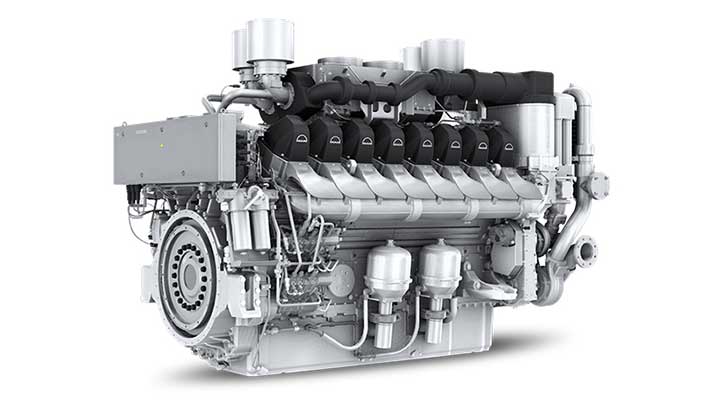
Through compact integration of the latest technology, our four-stroke engines are characterized by
- a clear-cut design,
- flexible ship integration,
- easy installation,
- simple operation, and
- straightforward maintenance.
Their modular design allow them to meet all the challenges of today’s different applications.
Comfort and hybrid solutions
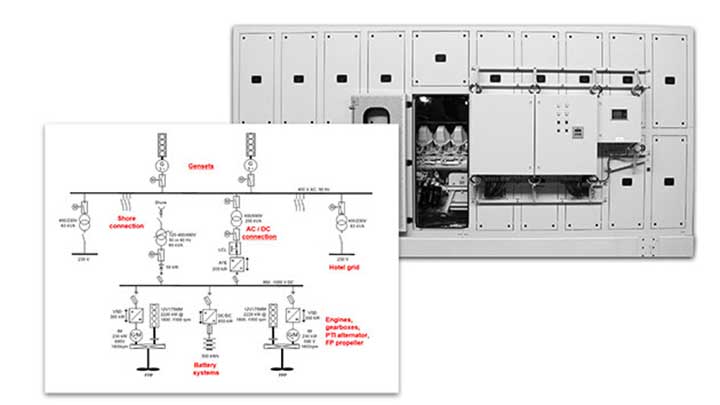
Benefits at a glance
- Silent and emission-free sailing with engines off for harbor entry and exit as well as island passages
- Enjoy silent harbor stays by taking hotel load purely from the battery
- Recharge the battery during voyages from the gearbox PTO, shore power or from the gensets
- Increase acceleration and emission-free maneuvering
- Achieve additional top speed in PTI booster mode
Powerful and compact
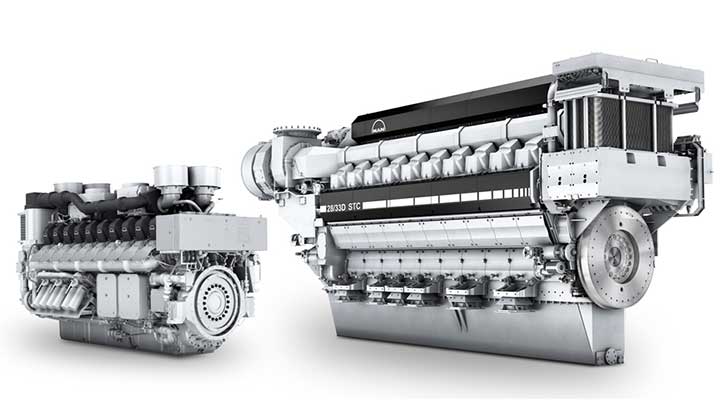
This range of MAN engine technology is always a reliable partner for your superyacht.
Low emission, high efficiency
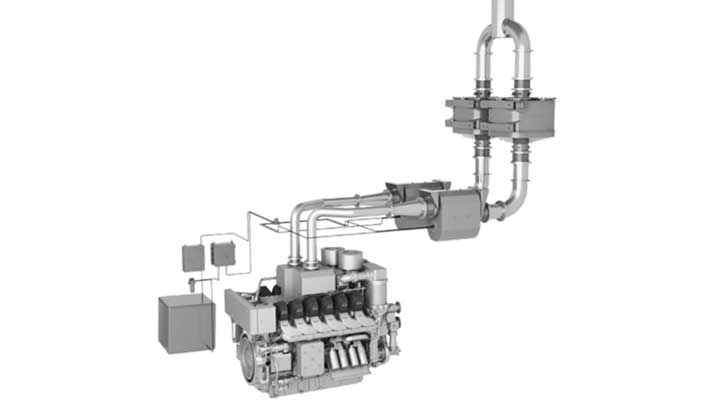
With best-in-class fuel oil consumption, our engines reduce the greenhouse gas emissions of superyachts.
By using synthetic fuels, the future of green CO 2 -neutral propulsion is already here.
To allow ecological competitiveness, IMO Tier III with compact SCR, customized diesel particle filter and silencer combinations are included.
Go to four-stroke propulsion
Go to MAN 175D
You never sail alone: MAN PrimeServ
MAN PrimeServ provides 24/7 service across the globe. Our range of services includes technical support, consulting, and spare parts, as well as maintenance, repair, and comprehensive individualized service plans for your superyacht.
How you benefit:
- Prompt delivery of high-demand spare parts within 24 hours
- Fast, reliable, and competent customer support
- MAN PrimeServ Academy: Ongoing training and qualification of operators and maintenance staff
- Diagnosis and troubleshooting with our PrimeServ Assist high-performance online service
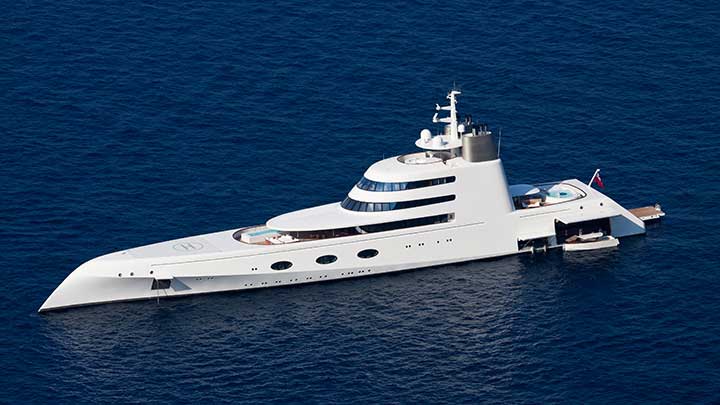
Are you looking for a strong partner in your superyacht business? Do you want to take the experience on your yacht to the next level?
Our experienced engineers are happy to design the perfect-fit solution for you. Start your engines now and reach out to us today.
Talk to our experts
Continue reading
- MAN 175D pdf, 5741 KB Download
- MAN 175D pdf, 6816 KB Download

Get free early access to a dvanced functions and special offers.
Privacy Policy and Terms and Conditions
World of Superyachts operates the https://worldofsuperyachts.com/ website, which provides the SERVICE.
This page is used to inform website visitors regarding our policies with the collection, use, and disclosure of Personal Information if anyone decided to use our Service, the World of Superyachts website.
If you choose to use our Service, then you agree to the collection and use of information in relation with this policy. The Personal Information that we collect are used for providing and improving the Service. We will not use or share your information with anyone except as described in this Privacy Policy.
The terms used in this Privacy Policy have the same meanings as in our Terms and Conditions, which is accessible at https://worldofsuperyachts.com/, unless otherwise defined in this Privacy Policy.
Information Collection and Use
For a better experience while using our Service, we may require you to provide us with certain personally identifiable information, including but not limited to your name, phone number, and postal address. The information that we collect will be used to contact or identify you.
We want to inform you that whenever you visit our Service, we collect information that your browser sends to us that is called Log Data. This Log Data may include information such as your computer’s Internet Protocol (“IP”) address, browser version, pages of our Service that you visit, the time and date of your visit, the time spent on those pages, and other statistics.
Cookies are files with small amount of data that is commonly used an anonymous unique identifier. These are sent to your browser from the website that you visit and are stored on your computer’s hard drive.
Our website uses these “cookies” to collection information and to improve our Service. You have the option to either accept or refuse these cookies, and know when a cookie is being sent to your computer. If you choose to refuse our cookies, you may not be able to use some portions of our Service.
For more general information on cookies, please read “What Are Cookies” .
Service Providers
We may employ third-party companies and individuals due to the following reasons:
- To facilitate our Service;
- To provide the Service on our behalf;
- To perform Service-related services; or
- To assist us in analyzing how our Service is used.
We want to inform our Service users that these third parties have access to your Personal Information. The reason is to perform the tasks assigned to them on our behalf. However, they are obligated not to disclose or use the information for any other purpose.
We value your trust in providing us your Personal Information, thus we are striving to use commercially acceptable means of protecting it. But remember that no method of transmission over the internet, or method of electronic storage is 100% secure and reliable, and we cannot guarantee its absolute security.
Links to Other Sites
Our Service may contain links to other sites. If you click on a third-party link, you will be directed to that site. Note that these external sites are not operated by us. Therefore, we strongly advise you to review the Privacy Policy of these websites. We have no control over, and assume no responsibility for the content, privacy policies, or practices of any third-party sites or services.
Children’s Privacy
Our Services do not address anyone under the age of 13. We do not knowingly collect personal identifiable information from children under 13. In the case we discover that a child under 13 has provided us with personal information, we immediately delete this from our servers. If you are a parent or guardian and you are aware that your child has provided us with personal information, please contact us so that we will be able to do necessary actions.
Changes to This Privacy Policy
We may update our Privacy Policy from time to time. Thus, we advise you to review this page periodically for any changes. We will notify you of any changes by posting the new Privacy Policy on this page. These changes are effective immediately, after they are posted on this page.
If you have any questions or suggestions about our Privacy Policy, do not hesitate to contact us .

World of Superyachts
1+ million superyacht specifications.
More results...
Try these: Eclipse Feadship 2016 MTU 162 m EvoJet
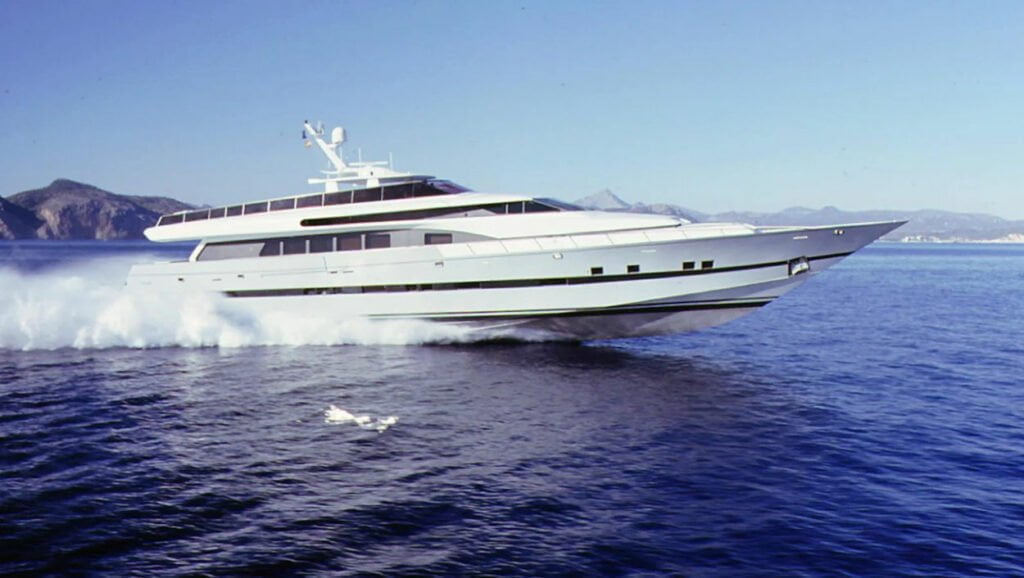
The World's Fastest Superyachts
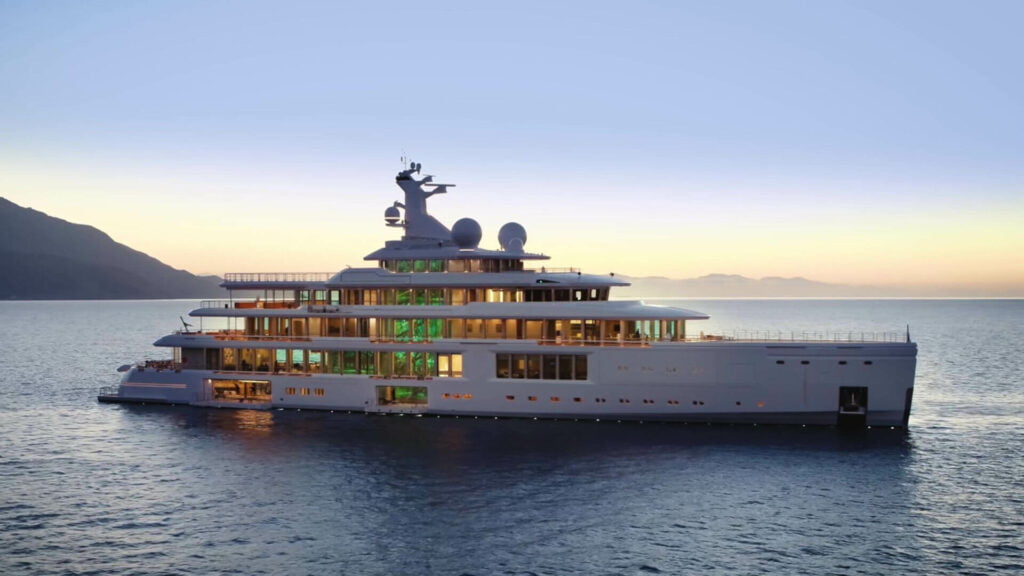
Electric Sophistication
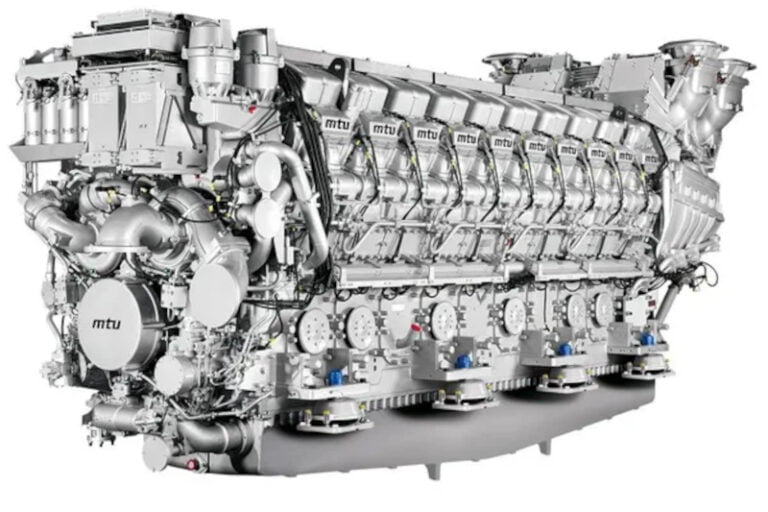
World's Most Powerful Superyacht Engine
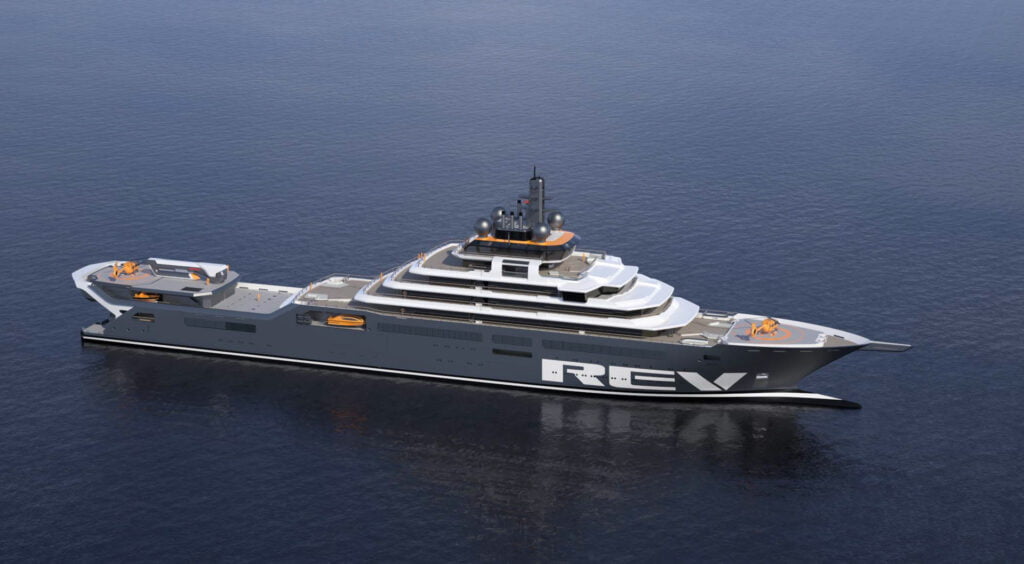
Top 25 Longest Superyachts
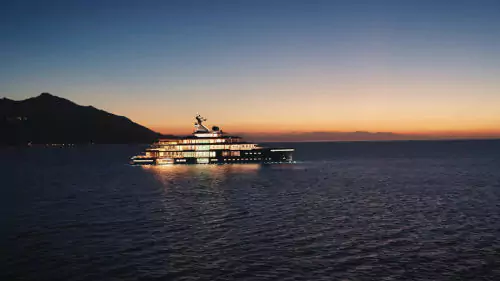
View Luminosity's deck plans
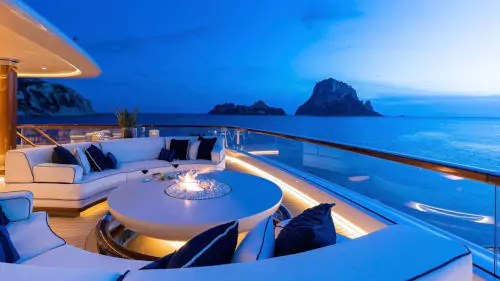
Superyachts, Superyachts, Superyachts
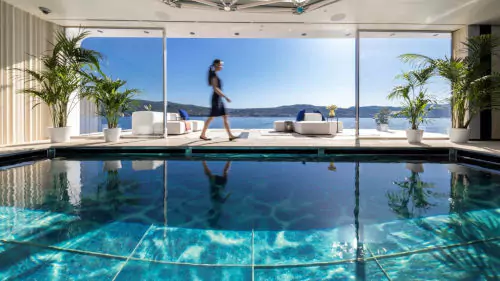
Enjoy the Beach Club of Seven Sins
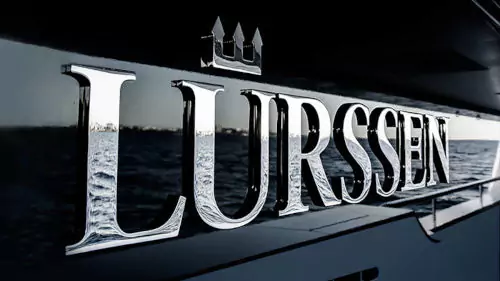
All of Lürssen's Superyachts

We're here to help
Don’t hesitate to reach out to us. We will gladly help and answer all your questions.
Over 1 million astonishing Superyacht specifications, deckplans, engines, tenders and much more.
Join us at the forefront of Superyachts and information from the World’s Top Echelon Marine Industry.

A basic overview of yacht engines

With thanks to Premier Separator Services & CONSO - Engine Parts, Maintenance & Servicing
Engines can be referred to as the beating heart of any motoryacht; responsible for getting a vessel going and keep it running through ocean waters. Yachting Pages explores the essentials of yacht engines for crew wanting to work in the engine room or for general engine enthusiasts, with help from John Warren at Premier Separator Services and Jean-Francois Conso from CONSO - Engine Parts, Maintenance & Servicing.
Search for engine service suppliers in your location on Yachting Pages.

Yacht engines: Does size matter?
As can be safely assumed, an engine for a 40ft yacht is not going to be the same as that of a 40m superyacht in terms of size, weight, power or complexity.
While engines for smaller yachts are technical in themselves, superyacht engines in particular are “extremely complex”, as John from Premier Separator Services explains, “On board a superyacht you have so many systems other than the main engine, from the auxiliary equipment and generators, to the air conditioning and sewage plant. In principle, the main difference between a yacht and superyacht engine is size, but superyachts are so much more complex and very efficient if maintained properly.”
Types of yacht engine
As Jean-Francois Conso from CONSO points out, “There are many engines ranging from six cylinder to 16 cylinder. There are also many brands, from MAN and MTU to Cummins, Deutz, Cat and Baudoin; however the most popular are MTU and Cat. These tend to be seen on board yachts ranging from 80ft to 80m long.
In terms of fuel, diesel tends to be the preference for yacht and superyacht engines and as technology has evolved, so diesel has become cleaner and engines are able to produce more power without burning more fuel.
However, diesel is not without competition, as alternative fuels such as liquid natural gas (LNG) look to compete and provide a ‘cleaner’ fuel source for the future.

Keeping your yacht engine efficient
Of course, like any engine, maintenance is absolutely essential to keep a yacht engine running smoothly at full power. Jean-Francois recommends using your engine at 80% of its full power for optimum performance, and following all maintenance recommendations from professional engine service suppliers.
Take a look at our guide on how to get the most out of a yacht engine , for further guidance and tips on the best maintenance and protection for a yacht or superyacht engine.

The engine room
Yacht engine rooms have changed dramatically over time, and aren’t necessarily the dark, dingy environments of the past. Some engine rooms are now so bright and meticulously designed, that guests on board large and luxurious superyachts are taken down to the engine room for a tour.
As yacht crew, the size of the engine room you’re working in will vary depending on the vessel and the engine’s complexity, but nevertheless, stepping in for the first time can be quite overwhelming for crew.
As John points out, it’s important to ease yourself in by first getting the lay of the land and familiarising yourself with every inch of the engine room, “Get to know your engine room, trace out all pipelines, whether that’s fuel lines, ballast lines or fresh water lines.
“Get to know each bit of equipment and if in doubt contact the manufacturer and ask for some advice; don’t be afraid to ask.”
If you’re interested in how other engine rooms are laid out on board, take a look at our yacht engines playlist on YouTube .

Getting educated with yacht engines
If you’re yacht crew looking to move into engineering, the first level qualification you’ll need is the Approved Engine Course (AEC) , known as the first level qualification, before progressing into gaining your Marine Engine Operator Licence (MEOL) and Yacht (Y4) certificate of competency.
Get more guidance on becoming a superyacht engineer with our guides on engineering training courses .
Search for engine service suppliers on Yachting Pages.
Tried & Tested

In the realm of maritime luxury, the quest to offer yacht charter guests the perfect night's sleep has become an art form, one which luxury bed and linen supplier, CC Design, has fully committed to.
A jacket completes any crew member's uniform so it's an important garment to get right. In this Tried & Tested, Sea Design pits eight popular jackets against one another to determine which one is best for superyacht crew in 2023.
iAQUA creates high-performance, technologically advanced underwater scooters. In this Tried & Tested, a team of experienced testers have rated and reviewed the AquaDart Pro and AquaDart Nano series to reveal the stand-out iAQUA sea scooter.
UK-based Solent University has launched a new Sustainable Marine Craft and Superyacht Design course, a brand-new MSc for...

Singapore Yachting Festival returns for its 2nd event from 25th to 28th April 2024! This years event will showcase an ex...

Popular Articles
Finished reading now find your perfect supplier..
Search our industry-leading directory for over 20,000 superyacht suppliers, providers and marinas.
- Motorcycles
- Car of the Month
- Destinations
- Men’s Fashion
- Watch Collector
- Art & Collectibles
- Vacation Homes
- Celebrity Homes
- New Construction
- Home Design
- Electronics
- Fine Dining
- Costa Palmas
- Reynolds Lake Oconee
- Scott Dunn Travel
- Wilson Audio
- 672 Wine Club
- Sports & Leisure
- Health & Wellness
- Best of the Best
- The Ultimate Gift Guide
7 Eco-Conscious Yachts That Are Changing the Future of Boating, From Zero-Carbon Catamarans to Hybrids
Pure-electric trawlers and hydrogen-powered sailing vessels sound like sci fi, but they'll be on the water soon..
- Share This Article

Yachting and sustainability may sound like a paradox, but we’re steadily seeing the marine world embrace eco-change. For the yachting world, there are an increasing number of ways to boat with a lower carbon imprint. From electric-diesel hybrids to zero-carbon catamarans powered by alternative fuel sources, here is a closer look at the newest eco-conscious yachts on the water—as well as several concepts that will be on the market in the next year, and a sailing vessel that helped start the emissions-reduction trend among superyachts.
Azimut Seadeck

Having the world’s largest yacht builder embrace sustainability promises to exert pressure on hundreds of smaller builders around the world. When the three-model Azimut Seadeck series is launched, the combination of complementary emissions-reducing technologies promises to be a major milestone for yachting.
“This is the most efficient yacht ever designed by Azimut,” said Federico Lantero, head of Product Design at Azimut/Benetti, at an event announcing the series. “We’ve identified the most recent technologies over the years, so we sat together said let’s raise the bar once again. Let’s push these technologies to the limits. It’s been like assembling a big puzzle.”
The Italian shipyard promises above-average efficiency at a wide range of speeds: The official estimates predict an emission reduction of 40 percent, thanks to Seadeck’s diesel-electric hybrid systems, lightweight carbon-fiber superstructure, solar panels, and other energy-absorption solutions.
Monaco-based designer Alberto Mancini, who penned the exterior, teamed up with other Italian designers Matteo Thun and Antonio Rodriguez, who completed the sleek interior design. Thun and Rodriquez infused the interior with the newest sustainable materials, including cork, which they describe as the “best alternative to teak.”
The concept of Seadeck’s large open aft section—dubbed “Fun Island,” follows the success of the extended deck of sister builder’s Benetti Oasis. That design was a game-changer in its wellness-outdoor living approach. Azimut will release the Seadeck models in the next 20 months, starting with the Seadeck 6 in early 2024.
Alva Yachts Ocean Eco 90 H2

In the past couple of years, German catamaran and sailboat builder Alva Yachts has turned heads with its innovative solar catamarans. But now it’s pushing boundaries farther with the announcement of what it’s calling “the first zero-emissions superyacht catamaran to run without fossil fuels.”
The Ocean Eco 90 H2 is a special 90-foot version of the Ocean Eco 90 series, the shipyard’s flagship model. It comes in two versions: full electric and hybrid diesel-electric. The new model is the company’s first venture into hydrogen. Dubbed a “fuel-less superyacht catamaran with wings,” the H2 was requested by an existing Alva owner. It is powered only by sustainable sources, including the sun, wind, electric energy, and hydrogen fuel cells. The company’s signature solar cells generate up to 40kWp of power while twin performance electric motors give power, with the aid of the Ayro Oceanwings wind-propulsion system.
Oceanco ‘Black Pearl’

The world’s biggest sailing superyacht— Black Pearl —is also the most sustainable boat on water. Energy is saved at every turn on board the 350-foot yacht, from the HVAC system to three carbon-fiber masts, striking black DynaRig sails and aluminum superstructure that combine to make the Oceanco yacht lightweight and efficient. Controllable pitch propellers feed power back into the yacht via a pair of shaft generators providing enough power to support the yacht’s hotel load. Equipped with battery banks and a waste-heat recovery system, the gigayacht is capable of sailing across the Atlantic using only renewable energy.
Sunreef 80 Eco Marie-Joseph

Formula One champion Fernando Alonso so enjoyed his Greek charter aboard the Sunreef 80 Eco Marie-Joseph last summer that he now has a Sunreef 60 Eco in build. Equipped with electric engines, Marie-Joseph is fitted with nearly 1,800 square feet of solar panels integrated into the yacht’s composite structures, including the mast, boom, superstructure and hull sides. It’s enough to generate up to 45.5kWh, which leaves the deck areas free for guest enjoyment. In addition to the yacht’s “solar skin,” the vessel also has a hydro-generation system, which recovers energy from the propellers as well as high-efficiency batteries.
Steeler 61S Electric

Designed by Vripack and built by Steeler, the 61-foot Steeler 61S Electric is a full custom electric trawler built for a liveaboard owner. Sustainable materials, such as steel, wood, leather and Flexiteek decking, give a nod to the owner’s determination to have a lighter carbon footprint—though the biggest sustainability breakthrough lies with the boat’s propulsion and slow-boating efficiency. Though equipped to run a 75kW diesel generator, the Steeler 61S Electric is also equipped with a 90kW electric motor and can run on shore power. In true Dutch style, solar panels and windmills mounted on the roof help feed the 184kWh battery pack.
Newcastle Marine ‘Safira’

When it comes to sustainability, every little bit helps. Powered by azipod drives, which provide 20 percent more efficiency than conventional shafts, the 129-foot Safira can also run on 15-percent biodiesel. The boat is fitted with LED lighting and good insulation, which allows for smaller generators and reduced fuel consumption. Environmental considerations extend to the choice of materials as well, with reclaimed oak, remnant stone and Esthec—a synthetic replacement for teak—being used for both cabinetry and exterior decks.
Rossinavi ‘No Stress’

Italian designer Enrico Gobbi’s latest project comes in the form of Rossinavi’s first hybrid yacht. Delivered earlier this month, the 169-foot, full-aluminum sports yacht, No Stress , is powered by two MTU 16V diesel engines and two electric motors. In electric mode, the dual power system is managed by an artificial intelligence (AI) system that monitors fuel consumption. No Stress forms part of the Italian shipyard’s aim to develop boats with BluE technology. In addition to more environmentally-friendly cruising, the inclusion of AI means the owners “can enjoy the electric experience on board to the fullest,” said Rossinavi’s COO Federico Rossi, in a statement.
The Italian yard recently launched another hybrid-electric “BluE” concept called Infinity , a sailing yacht with an exterior by Fulvio de Simoni. The 138-footer has solar panels that can be stored so that yacht can navigate in full-electric mode for 90 percent of an average day. De Simoni also penned Rossinavi’s Sea Cat hybrid cat, which is currently under construction.
Read More On:
- Sustainability
More Marine

David and Victoria Beckham Spiced Up Their Family Easter on This 130-Foot Superyacht

Work From Sea? This New 197-Foot Superyacht Doubles as a Floating Executive Suite

This 112-Foot Superyacht Has an Interior That’ll Make Your Manhattan Condo Jealous

This New Superyacht Comes With a Motorized Rescue Buoy That Can Cruise to Anyone Overboard

Culinary Masters 2024
MAY 17 - 19 Join us for extraordinary meals from the nation’s brightest culinary minds.
Give the Gift of Luxury
Latest Galleries in Marine

The 11 Best Water Toys for the High Seas, From Electric Surfboards to Personal Subs

Unica 40 in Photos
More from our brands, exclusive: acne studios taps montblanc exec as cfo, another ratings record falls as iowa advances to the final four, india’s jio studios chief reveals slate, strategy: ‘we’ve hit a purple patch, like tendulkar hitting centuries’ (exclusive), a trans-led art collective is shifting perceptions around transgender people in india, this best-selling under-desk walking pad is over $100 off on amazon today.
- Today's news
- Reviews and deals
- Climate change
- 2024 election
- Fall allergies
- Health news
- Mental health
- Sexual health
- Family health
- So mini ways
- Unapologetically
- Buying guides
Entertainment
- How to Watch
- My watchlist
- Stock market
- Biden economy
- Personal finance
- Stocks: most active
- Stocks: gainers
- Stocks: losers
- Trending tickers
- World indices
- US Treasury bonds
- Top mutual funds
- Highest open interest
- Highest implied volatility
- Currency converter
- Basic materials
- Communication services
- Consumer cyclical
- Consumer defensive
- Financial services
- Industrials
- Real estate
- Mutual funds
- Credit cards
- Credit card rates
- Balance transfer credit cards
- Business credit cards
- Cash back credit cards
- Rewards credit cards
- Travel credit cards
- Checking accounts
- Online checking accounts
- High-yield savings accounts
- Money market accounts
- Personal loans
- Student loans
- Car insurance
- Home buying
- Options pit
- Investment ideas
- Research reports
- Fantasy football
- Pro Pick 'Em
- College Pick 'Em
- Fantasy baseball
- Fantasy hockey
- Fantasy basketball
- Download the app
- Daily fantasy
- Scores and schedules
- GameChannel
- World Baseball Classic
- Premier League
- CONCACAF League
- Champions League
- Motorsports
- Horse racing
- Newsletters
New on Yahoo
- Privacy Dashboard
Billionaires are getting ready for summer with wildly spectacular superyachts
Superyachts, the most expensive asset a billionaire can own, are pushing the boundaries of luxury.
The boats, which cost eight or nine figures, are getting larger and include more features than ever.
From massage rooms to basketball courts, here's what the world's richest want on board.
For many wealthy boat owners, a private spa is a must-have on board. A sauna is a nice touch. A Jet Ski or two makes days at sea way more fun. And if you don't have someone on board who can whip up a Michelin-star-worthy meal , you might as well stay on land.
In the world of massive yachts , there's no such thing as too much. After all, if someone spends eight or nine figures to design the vessel of their dreams — or at least $500,000 a week to charter one — more is more.
"Yachting. It's not rational; it's emotional," Ralph Dazert, the head of intelligence at SuperYacht Times, told Business Insider at the Palm Beach International Boat Show, where dozens of superyachts — often defined as vessels over 30 meters in length — were on display.
And while there are certain classic features, such as jacuzzis and bars, what superyacht owners want is evolving, insiders at the show said. That might mean more crew members, more space for helicopters, or more water toys, but might also include manicure salons and putting greens.
"The bar of what is the baseline expectation has increased exponentially just over the last four or five years," Anders Kurtén, the CEO of brokerage Fraser Yachts, said. Clients are "spending more time on the boat and really wanting to extend the lifestyle they lead on the shore."
A lot of this can be chalked up to the pandemic. Superyacht purchases and charters spiked as life and luxury travel on land screeched to a halt. While the market has moderated slightly, the number of superyachts on order — 1,166 as of September, according to Boat International's Global Order Book — is still above pre-pandemic norms.
"What the pandemic really showed is that the appetite for being out there at sea, sort of living the marine lifestyle, is still as valid as ever," Kurtén said.
That means there's a lot of money on the water. The total value of the 203 superyachts over 30 meters delivered last year was $6.4 billion, according to data from SuperYacht Times. New custom builds from the world's most prestigious shipyards — Lurssen, Feadship, Oceanco , Benetti — can run into the hundreds of millions. Even used superyachts at the Palm Beach show cost as much as $75 million.
And it's not just traditional buyers like retired wealthy couples looking for a place to relax or celebrities looking for a place to party away from the paparazzi. New clients are often younger and have families, so want areas to work and watch movies . They also want pricey water toys, access to fitness equipment, or even pizza ovens for picky eaters.
"This would've never happened in the nineties," said Giovanna Vitelli, the vice president of the Azimut Benetti Group, the world's biggest producer of superyachts. "You would go with your beautiful woman, Champagne — the idea of yachting was much more showing off with your jacuzzi and things like that."
Pure opulence has made room for function.
When Benetti's Nabila set sail in 1980, its 50-person crew, gold-and-diamond-encrusted interiors, and lavish parties captured headlines and even inspired the Queen song "Kashoggi's Ship."(Seven years later, Donald Trump bought Nabila for $30 million , renaming her the Trump Princess.)
"Life on board was considered very formal — big formal dining rooms, boats were high on the water, you would be segregated from the rest of the world," Vitelli said, remembering another client who insisted on a replica of the Sistine Chapel above the dining table.
But the ostentatious, palatial-like interiors that used to be highlighted in yacht brochures have made way for lists of more functional features .
Rather than esoteric novelties like an extra-large safe for rifles that one builder had to construct per a Russian yacht owner's request , the superyachts on display at the Palm Beach show featured basketball courts, saunas, and ice baths.
Owners want elevators and luxury gyms. Pampering options, be it a massage room, manicure station, or a professional-grade facial machine, are a dime a dozen. Some bathrooms have fancy Toto toilets, which can cost around $20,000.
Sterns (that's the back of the boat) used to be built high to guard guests' privacy. Now, they're built as "beach clubs" — an open swim platform.
And what good is a massage room if no one on board can give one? Many superyachts can hold twice as many crew members as guests, if not more. One broker, representing a boat that didn't have a masseuse, said it could be quite a "tricky" issue because if a charter wants one, they have to find someone who can massage guests and "pull their weight with the crew."
"It's not uncommon to look for a deckhand who can also mix a martini, play an instrument, maybe entertain the guests with singing, and ideally even give a massage," Kurtén said.
Of course, a crew comes at a cost . Most are considered full-time employees, requiring salaries and benefits like health insurance. Captains, first mates, and chief engineers often make six figures a year. That's without tips; a charter guest will typically spend six figures on gratuities for the crew who worked during a weeklong vacation.
For the superrich, there must be room for toys.
It's not just the onboard amenities that count. What's known as "toys" in the industry — water slides, eFoils, Jet Skis, and underwater scuba diving jets — are popular, and costs range from merely hundreds of dollars (banana boats) to millions ( submersibles , which are still popular despite the recent tragedy).
" Tenders and toys, the sky seems to be the limit," Kurtén said. "More is more."
If you can't fit all those toys in the yacht's storage space, you can just use another boat. Jeff Bezos' support yacht is a superyacht in itself, measuring 75 meters and costing tens of millions of dollars. (His main yacht, Koru , cost a reported $500 million.)
Support yachts are also faster, meaning the crew can get to a destination first and set up the Jet Skis, seapools, and the like, Dazert said. "By the time the owner arrives on the main yacht, everything's set up, and he can go and have fun."
Even tenders, the smaller vessel that brings guests from the ship to the shore, are getting glow-ups. The Nero, a 90-meter beauty available to charter for about $500,000 a week and modeled after J.P. Morgan's 1930s ship, has custom-built tenders to match the design. The most expensive ones often cost seven figures. Nero has three.
"It used to be a tender was a tender," Jeffrey Beneville, who handles yacht insurance at NFP, told BI. "Now they're called limousine tenders. Think of an incredibly luxurious gondola that's got a hard top so nobody's hair gets mussed when they're being dropped off at the Monaco Yacht Club ."
One thing that clearly hasn't changed in superyachting: showing off. If the boat next door at the marina has an indoor-outdoor cinema, it's natural to want one too. Ditto a wine cellar or helipad.
"It's a bit of a celebration of your success in life, of wealth," Vitelli, whose company is behind the Lana yacht Bill Gates chartered for a birthday party three years ago, said. "You push it a little more."
And that's a boon for yacht makers and brokers catering to the superrich.
"Our job is to make clients' dreams come true," Kurtén said.
Read the original article on Business Insider
Recommended Stories
Indian government's cloud spilled citizens' personal data online for years.
The Indian government has finally resolved a years-long cybersecurity issue that exposed reams of sensitive data about its citizens. A security researcher exclusively told TechCrunch he found at least hundreds of documents containing citizens' personal information — including Aadhaar numbers, COVID-19 vaccination data, and passport details — spilling online for anyone to access. At fault was the Indian government's cloud service, dubbed S3WaaS, which is billed as a "secure and scalable" system for building and hosting Indian government websites.
Trump legal news brief: Billionaire Don Hankey’s company covers Trump’s $175 million fraud trial bond
Knight Specialty Insurance Co. loans former President Donald Trump $175 million to cover the bond required to prevent New York Attorney General Letitia James from seizing his assets while he appeals the $454 million judgment in his financial fraud trial.
Kansas City ballot measure for new Royals stadium, Chiefs renovations fails hard at polls
The Royals are still looking for a new stadium.
Bryce Harper posts 3-HR night to break season-opening hitless streak
The Phillies star entered Tuesday slugging .000. He is now slugging .800.
Couple injured in Rashee Rice crash reportedly lawyers up: 'They're angry'
Rice reportedly owned the Corvette and leased the Lamborghini involved in the crash.
Armor All's 'Get Ready For Spring' event is back with even better car cleaning deals than before
Need to pick up some car cleaning gear? Armor All is one of the best brands in the game. Claim up to 47% off thanks to this Amazon sale!
Angie Harmon says Instacart driver fatally shot her dog: Here's where the investigation stands
Angie Harmon says her family is "traumatized" and "devastated" after an Instacart driver shot and killed her dog. The man claimed self-defense to police.
Photoncycle targets low-cost energy storage with a clever hydrogen solution
For years, the solar energy sector has grappled with interseasonal energy storage. The ability to harness the surplus solar energy of summer months for use during the winter has remained an elusive goal, with existing solutions like batteries falling short due to prohibitive costs and limited lifespans. With a vision as bright as the summer sun, the startup claims its solid hydrogen-based technology can store energy more efficiently in an ammonia synthesis reactor.
What can we expect from Caitlin Clark and Angel Reese at the next level?
Clark is a near lock to go No. 1 overall in the WNBA Draft, but Reese’s draft picture and professional future — if she were to leave LSU — are much murkier.
Titans CB L'Jarius Sneed says 'nothing wrong with my knee' after $76 million extension
The Titans guaranteed $55 million to Sneed after trading for him.
Are Giannis Antetokounmpo & the Milwaukee Bucks ready for the playoffs? | Devine Intervention
Dan Devine is joined by Frank Madden from Locked On Bucks to discuss a Milwaukee Bucks season that has included two new head coaches and a new superstar (Damian Lillard) to pair with Giannis Antetokounmpo.
Chop chop! This Cuisinart knife set is just $22 — that's 65% off at Amazon
'Where have these been all my life?' Nearly 5,000 5-star reviewers say these colorful knives are a cut above the rest.
Thrive Market's Nick Green talks building a billion-dollar grocery company
Nick Green, one of the company's co-founders, stopped by Found to chat about his company and the market's evolution since he first launched it. This argument is what helped Thrive Market become the first online grocery retailer that the USDA approved to accept food stamps. Thrive Market had to raise money from content creators and influencers until VCs picked up on the craze.
Eclipse weather forecast: Where you'll be able to see it — and where viewing could be difficult
Preliminary local forecasts in 13 states along the so-called path of totality show viewing the highly-anticipated celestial event may be a problem for some, less so for others.
Lexus LY 680 pushes Lexus' lifestyle aspirations further out to sea
The Lexus LY 680 yacht updates the 2018 LY 650 yacht with more length and more room for passengers. It's available in Japan for now, starting at $5.1 million.
We want to hear from you: Where were you the day Kurt Cobain died?
Share what Kurt Cobain meant to you in 1994 — and what he still means to you today — for an upcoming Yahoo story.
GM US sales dip 1.5% in Q1, but retail deliveries jump 6%
GM reported Q1 sales figures for the US that topped estimates, though they were down compared to a year ago due to lower fleet sales. GM said sales of trucks and pickups powered results at the retail level.
Spotify's subscriber audiobook credit is coming to Canada and other countries next week
Spotify Premium subscribers in Canada, Ireland and New Zealand will soon get 15 hours of audiobook listening each month at no extra cost. Users in the US, UK and Australia have had access to this perk since late last year.
Crude oil prices reach highest since October as energy stocks lead market
US crude futures have gained 20% this year and pushed energy stocks to outperform the market as rising geopolitical tensions and lower supply buoy prices.
How much Americans think they need for retirement vs. what they actually have saved are miles apart
The "magic number" for retirement savings has swelled to an all-time high, but Americans are worried they won't reach it.
What yachting industry insiders have to say about Jeff Bezos' superyacht
- Jeff Bezos' yacht , which reportedly cost $500 million to build, completed its first year at sea.
- The superyacht, Koru, was a frequent topic of conversation at the Palm Beach boat show.
- Here's what industry insiders think about the vessel.

It's been just about a year since Koru, Jeff Bezos ' $500 million megayacht, set sail from the Oceanco shipyard in the Netherlands, capturing the attention of yachting insiders and land dwellers alike.
Even after her first season at sea, the 127-meter ship is still one of the most talked about vessels among those in the know — and not just for the busty figurehead on its prow, which many have wrongly speculated is based on Bezos's fiancée . Koru was a hot topic at the annual Palm Beach International Boat Show, where the yachts of other billionaires were on display for sale or charter.
The overwhelming response from those Business Insider spoke to was awe, with many praising her unique design, commenting on her immense size, or remarking that they'd been lucky enough to see her up close.
"It's absolutely beautiful," said Federico Rossi, the COO of luxury yachtbuilder Rossinavi.
Still, due to the small size of the industry — and the fact that privacy is paramount in the yachting community — even those who complimented Koru mostly did not want to go on record in order to protect professional relationships.
"That thing's amazing," one such superyacht expert told BI. "It's very well done in terms of craftsmanship."
Unlike many other megayachts, Koru, which media billionaire Barry Diller's Eos inspired, is designed as a sailing yacht. That bucks the current trend of more severe-looking explorer boats — though Koru's 75-meter support vessel Abeona is of a more typical style,
"I heard back in 2018 or something that somebody had ordered a classic sailing yacht," the superyacht expert also told BI. "You order 125 meters, that's not really going to be classic. But it is. I think it's pretty cool."
Like most other megayachts, Koru is powered by her engines, which are reportedly innovative in their use of a kinetic energy recovery system. Industry experts, therefore, pointed out that her sails are more for looks than anything else — but that still works in her favor, with many praising her overall aesthetic appeal.
Related stories
"It's stunning," added a captain who has worked on several megayachts. He said he'd seen Koru in St. Barts, a favorite spot of Bezos and his fiancée Lauren Sanchez , over the holidays.
"There are definitely uglier boats out there," one yacht architect said. "It's not like it's shaped like his rocket," he jokily added, referring to the phallic design of Blue Origin's New Shephard .
Some, though, think the yacht is a bit excessive — which is saying something in a world where bigger is better and $250 million is a normal amount to spend.
"That's over the top. That's an insanely ridiculous boat," a longtime broker who favors discretion said. It's a "whole big show."
And the expert who praised the yacht's craftsmanship balanced his admiring comments by saying Koru's liberal use of teak — a wood traditionally used for yacht decks — was "bizarre."
The material has gained a bad reputation in the industry in recent years, as it typically comes from Myanmar, a country with a checkered human rights record. Plus, it takes a long time to grow, leading to deforestation.
Many shipyards have now turned to alternatives, like bamboo or plantation-grown teak, in their pushes toward sustainability. Bezos' team did not respond to BI's question about the origin of the deck's wood.
Teak or not, the yachting industry isn't generally known for being all that environmentally friendly — or indeed lowkey, so many who BI talked to didn't buy into the idea that Koru is "too much."
"If this is genuinely Jeff's dream come true, then great," Anders Kurtén, the CEO of brokerage Fraser Yachts, said. "I'm genuinely happy for him, and I'm happy for the people who got the opportunity to have employment to work on that."
And Bezos, of course, isn't the only billionaire with a stunning yacht . Billionaires like Jerry Jones and Bernard Arnault have also, at times, turned heads with their boats.
Most recently, insiders have tied Mark Zuckerberg to a 118-meter ship named Launchpad . It's the latest superyacht to capture the yachting world's attention.
So, as she sets sail for her debut summer season, Launchpad may take Koru's place as the main yacht on everyone's radar this year.
Watch: Walmart heiress' superyacht vandalized by activists in Ibiza
- Main content

IMAGES
VIDEO
COMMENTS
Caterpillar offers a wide variety of yacht engines such as the series C12, C18, C32, 3512C as well as VM32C with a performance range between 500 to 8000 KW and 660 to 11000 HP. At the moment Caterpillar manufactures 18 different models of the series mentioned above that are suitable for exclusive yachts, speedboats, and fishing vessels.
Most modern yachts utilize a reciprocating diesel engine as their prime power source. Due to their operating simplicity, robustness, and fuel economy. Compared to most other prime mover mechanisms. The rotating crankshaft can be directly coupled to the propeller with slow speed engines. Or via a reduction gearbox for medium and high-speed engines.
How superyacht diesel engines work. 21 January 2015 • Written by Dudley Dawson. The diesel engine has developed considerably since Rudolf Diesel first proposed a compression-ignition method of burning diesel fuel back in 1893 The vast majority of yachts today are powered by diesel engines. The basic technology has been around for more than a ...
#superyachts, #yachtengines, #yachtlifeSuperyachts are luxurious pleasure vessels that are built to bring joy. There is no definition of what kind of yacht y...
A superyacht or megayacht is a large and luxurious pleasure vessel. ... The 20 fastest superyachts ranged in speed from 50 knots (93 km/h) with 7,290-horsepower (5.44 MW) engines to 67 knots (124 km/h) with 20,600-horsepower (15.4 MW) engines for the motor yacht, ...
Conventional Diesel Engines. Many superyachts, even the fastest ones, are powered by conventional diesel engines. These engines typically run on marine-grade diesel fuel.They use a system of pistons and crankshafts to convert the energy from diesel combustion into mechanical power, which turns the yacht's propellers.
1. Foners - 70.1 knots. The Foners is currently the fastest super yacht in the world, with a 70.1 knots top speed, keeping the first spot since its delivery back in 2000. The power behind its top speed comes from two MAN engines and three Rolls Royce gas turbines, combining together to output a whooping 21,380 hp.
Over 1 million astonishing Superyacht specifications, deckplans, engines, tenders and much more. Join us. Join us at the forefront of Superyachts and information from the World's Top Echelon Marine Industry.
What's particularly special about this yacht is the 16-cylinder engine equipped with integrated Selective Catalytic Reduction (SCR). Designed to substantially reduce nitrogen oxide emissions, it will allow yacht owners to enter emission-controlled areas (ECA zones) such as the coastal waters of Canada and the USA, as well as the Caribbean and the North and Baltic seas, without compromising ...
The Virgen del Mar VI is a 30-meter superyacht designed by Omega Architects and built by Alia Yachts in 2018. It is powered by two Yanmar 6HYM-WET high-speed engines, producing 1400 mhp. These engines are known for their reliability, performance and efficiency, making them ideal for powering superyachts like the Virgen del Mar VI.
The Series 2000 and 4000 mtu engines for yachts have been approved for release by the engine specialists…. Rolls-Royce has released its two new superyacht engines capable of using synthetic diesel fuels - the Series 2000 and 4000 mtu. These fuels include BtL (Biomass to Liquid), HVO (Hydrotreated Vegetable Oil) and PtL (Power to Liquid ...
4. 'Galeocerdo' | 74.8 mph. Wally founder Luca Bassani designed the 118-foot Galeocerdo to maintain speed in rough seas. Launched in 2003 by Rodriquez Yachts, the boat racks up an eye-watering ...
Amare II can can reach speeds of 17.2 knots / ©Dick Holthuis. Builder: Heesen. Year of build: 2020. LOA: 164ft. Number of guests: 12. Number of crew: 9. Delivered in June 2020, Amare II is one of the newest hybrid superyachts to hit the water. Custom built by Dutch shipyard Heesen, her sea trials were completed during the height of lockdown ...
The 25 Greatest Superyachts of the Past 100 Years. Yacht design and technology—from steam engines to hydrogen fuel cells—have changed dramatically over the last century. These 25 standout ...
Caterpillar Marine's SCR system showcases its dedication to sustainability, helping the superyacht industry make steps towards a reduced-carbon future. To find out more about Caterpillar's engine and generator offerings to the yachting industry, contact your nearest dealer today. Caterpillar Marine has emerged as a leader in the engines and ...
"A superyacht's engines are typically rated for a maximum vessel speed of, say, 18 knots, but the yacht may for a significant part of its life idle around at speeds between nine and 12 knots," says Riccardo Repetto, global segment manager, yachts at ABB Marine & Ports. "Apart from reducing fuel efficiency, operating at lower loads ...
Superyacht services. Peace of mind matters. Our systems include an exclusive, around-the-clock support program at no extra cost, to help you make the most of your time at sea. Volvo Penta Yacht Series Support is available for all leisure yachts powered by Volvo Penta IPS 500-650 in triple or quadruple installations, or IPS 700-1200 in twin ...
Take a tour of Lurssen's, Tis yacht. In this video we take a quick look at the engine room. One of the largest giga yachts in the world. This yacht featur...
Our engines, and in particular the MAN 175D high-speed engine, are perfect matches for superyachts, combining a premium design, luxurious comfort, the highest power, and the best fuel economy. Powerful and agile solutions. Superyachts need superior technology to maintain comfort and a premium experience wherever you want to go. Thanks to their ...
Koru is a luxury custom superyacht owned by Jeff Bezos, the founder of Amazon. The vessel was built in the Netherlands by Oceanco starting in 2021, and delivered in April 2023. [3] [4] [5] It is a three-masted sailing yacht 127 meters (417 ft) long and reported to have cost $500 million or more. [6] [7] [8] When commissioned, the yacht was the ...
World's Most Powerful Superyacht Engine. Top 25 Longest Superyachts. View Luminosity's deck plans. Superyachts, Superyachts, Superyachts. Enjoy the Beach Club of Seven Sins. All of Lürssen's Superyachts. World of Superyachts. We're here to help. Don't hesitate to reach out to us. We will gladly help and answer all your questions.
By 2021, a sail correction was developed, a shore power study conducted, and upstream diesel assessed, adding important details to the index. By 2022, YETI 1.0 launched, adding an engine and ...
As Jean-Francois Conso from CONSO points out, "There are many engines ranging from six cylinder to 16 cylinder. There are also many brands, from MAN and MTU to Cummins, Deutz, Cat and Baudoin; however the most popular are MTU and Cat. These tend to be seen on board yachts ranging from 80ft to 80m long. In terms of fuel, diesel tends to be the ...
The world's biggest sailing superyacht—Black Pearl—is also the most sustainable boat on water. Energy is saved at every turn on board the 350-foot yacht, from the HVAC system to three carbon ...
The total value of the 203 superyachts over 30 meters delivered last year was $6.4 billion, according to data from SuperYacht Times. New custom builds from the world's most prestigious shipyards — Lurssen, Feadship, Oceanco, Benetti — can run into the hundreds of millions. Even used superyachts at the Palm Beach show cost as much as $75 ...
Amazon founder Jeff Bezos' superyacht Koru, which cost a reported $500 million to build, was a big topic of conversation at the Palm Beach boat show.